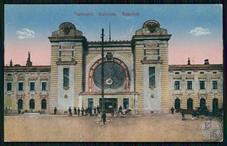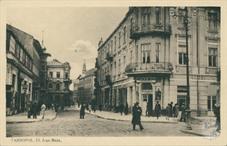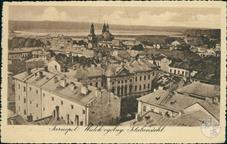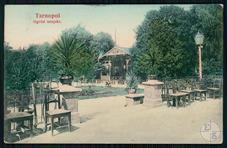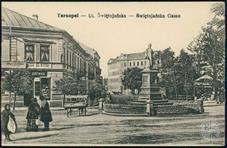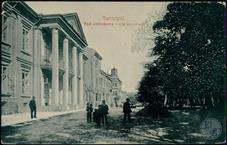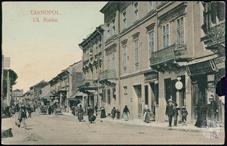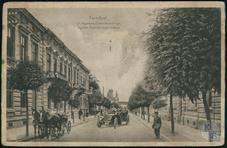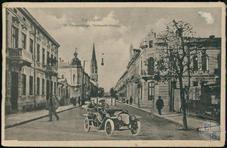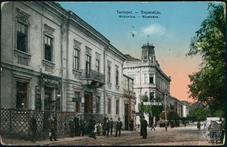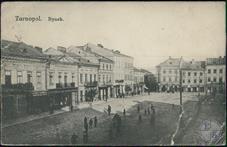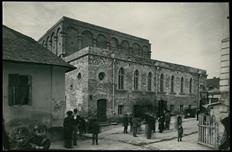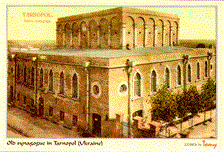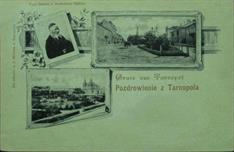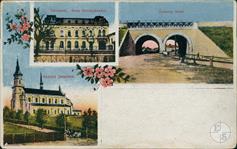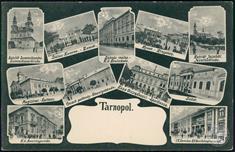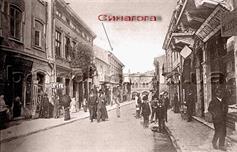Ternopil
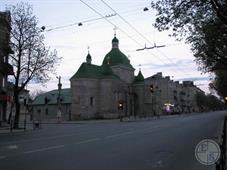 |
 |
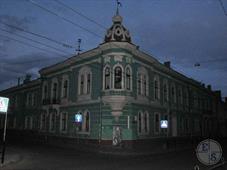 |
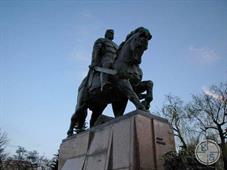 |
| Christmas Church | |||
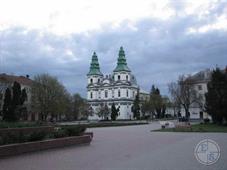 |
 |
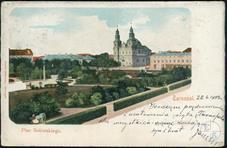 |
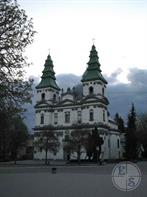 |
| Dominican church | |||
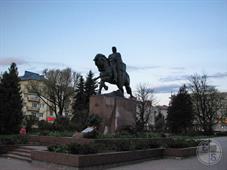 |
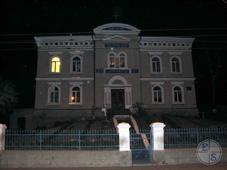 |
 |
 |
| King Danila Galitsky | Hospital | ||
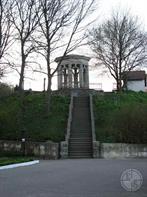 |
 |
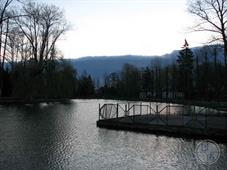 |
 |
| Ternopol Pond | |||
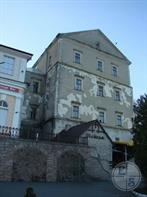 |
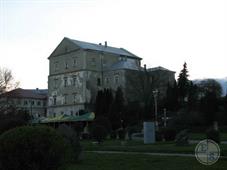 |
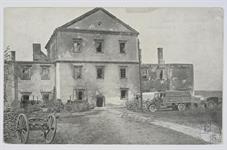 |
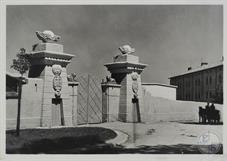 |
| Castle | |||
 |
 |
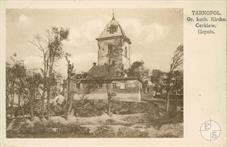 |
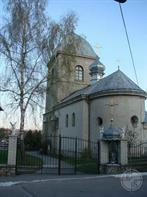 |
| Castle in the picture of Napoleon Orda | The Church of the Exaltation |
Ternopil, 2013
Ternopil region
The governor of Krakow, Jan Tarnowski, established Tarnopol in 1540 as a private town, and this is the origin of its name. This city was intended as a citadel against the invasion of the Tartars and the Wallachians, and it was a part of the fortifications of the Polish frontier. In 1548 Tarnopol received the privilege of having the Magdeburgian Laws. Tarnopol received the Emporium Right in 1566, (the duty of storing the merchandise of the merchants who were going through the town, and the privilege of the people of the town to be the first to buy the merchandise). The place was fortified and strengthened during the invasion of the Tartars in the years 1575 and 1589. In 1621 it became the property of Chancellor Tomash Zamoiski. During the years 1648 and 1653 Tarnopol suffered from Cossack and the Tartar invasions, which caused the total loss of the palace and the town. The new proprietor of the town, Alexander Konyetspolski, reconstructed the town, but in 1672 the Turks attacked the town and it was devastated again. Three years later the Turks bombarded the town's castles and the citadels, and caused a great deal of damage. In 1690 the town became the private property of the Polish royal family, Subiesky, and afterwards it was transferred to the Pototski noble family. It was their property until 1843, the year when private ownership of the city was abolished.
In 1694 the Tatars tried for the last time to invade the city, but they were repulsed. In the eighteenth century, the town endured Russian and different Polish confederations (political and military unions of the Polish nobility). In 1770 the Black Plague struck the town, and many of its people died of it. In 1772 the town was annexed to Austria, with the whole district of Galicia. From 1809 until 1815 the Russians owned the town. Afterwards Tarnopol was under the reign of Austria until 1918. From November 1918 until the end of that year, Tarnopol was part of the Western Ukrainian Republic. From the end of 1918 until September 17, 1932 Tarnopol was a district town of independent Poland.
The beginning of the Jewish settlement of Tarnopol was after the establishment of the town. The privilege that the king gave the Jews in 1550 included permission to live in all the parts of the town except the market square. Ten years later a few dozen Jews lived in the town. You can ascertain this from the head tax the Jews paid. In 1564 the revenues of the tax were 20 zlotys. The year after they were 23. In 1623 there was a big fire in the town, and the houses of the Jews also suffered damage. The city's owner, Tomas Zamoiski, gave the Jews the privilege of building their houses in all parts of the city (except the market square), and also to build a new synagogue instead of the former, which was burnt. The Jews began the synagogue in a citadel style, and the protection of the synagogue building was the obligation of the Jewish population. It was inaugurated during the 1740's. This privilege also included the right to buy and sell goods, except some limitations on leather merchandise, in order to keep the rights of the Christian shoemakers, who had a monopoly in this branch. According to the ratification of the city owner, the Jewish butchers were permitted to build a butcher shop again. For this they had to give ten milk stones (a Polish weight) annually to the citadels i.e. the owner of the city.
In 1625 the Jews of Tarnopol got the privilege of producing and selling mead, but they were not permitted to buy land and cultivate fields. It seems that there already were well-to-do merchants in Tarnopol. You can see it from the fact that in 1633 the Jewish merchant Baruch Ben David took a loan with a promissory note of 2,000 florins to buy goods during the fair that took place there. The regulations of the owners of Tarnopol permitted Jewish artisans to work in their professions, but they were obligated to sign an agreement with Christian guilds. The agreement from 1632 obligated the Jewish tailors to pay an annual tax of eight zlotys to work in their profession.
Till the Cossack pogroms of 1648 and 1649, the Jewish community was quite prosperous. Then there were about 300 families. There was a cemetery in Tarnopol and a glorious synagogue. The Tarnopol community was under the jurisdiction of the Rabbi Meir Ben Rabbi Yitzhak Tarnopoler did not exaggerate when he said, “Our community, Tarnopol, is the capitol.” (i.e. it was important).
The majority of Tarnopol's Jews fled from the town during the pogroms of 1648 and 1649. The Cossacks murdered all those who remained in Tarnopol during the Cossacks and the Swedes' Wars, and Tarnopol's Jews were obligated to defend the town with the rest of the people. They had to be armed with rifles and gunpowder, and also to buy cannon. The obligation of defending the synagogue, which was a citadel, and also to defend castles and gates, which were essential to Jews, was the main responsibility of the Jewish artisans' unions. During the period of these unions, a commander was nominated, nicknamed “Hetman Zhidovski” (the Jewish commander).
The community was renewed after the Cossacks' and Swedes' Wars, in the 1760's, but the economic situation of the Jews who returned to Tarnopol was bad, and the Saymik Convention (of the nobility of the district) that conferred in Halich in 1675, decided to ask it (the parliament of the nobles) in Warsaw, to free Tarnopol Jews from a head-tax. The Saymik said that the Jews of Tarnopol couldn't pay the tax because many of them were murdered, and the minority that remained couldn't pay great sums of money. The reconstruction of the city occurred when the Subieski family owned the city, and it flourished afterwards during the ownership of the Pototski Family. At the end of the seventeenth century and the beginning of the eighteenth, Jewish merchants mostly dealt in grain and cattle. This trade flourished especially when the frontier between the Turkish Empire and Poland was closed for twenty-seven years, till the Peace treaty of Karlovitske (1699).
In the Tarnopol fairs, which sometimes lasted for a month, merchants took part from all the cities of Reissen and especially from Brody. They bought agricultural goods from the whole district of Podolia, which has very good crops, and sold them in Germany and Silesia. They imported industrial goods from there, stored them in Tarnopol, and sold them throughout the Tarnopol area. The relatively good status of the Jews of Tarnopol, in comparison with other communities, can be discerned from the regulations, which were given to them by the city owner, Yosef Potowski in 1740. The Jews were free to live all over the city and trade (except Sundays and Catholic holidays, at which time the trade was limited until after the time of prayer in Catholic churches). The Jews got half of the slaughter in the town, and according to it, half of the butcheries. For this the Jews had to pay two milk stones. The Jews were permitted to run pubs, produce and sell liquors, and pay a liquor tax. For this the Jewish artisans were obligated to list themselves in the Christian artisan's union, but did not have to take part in religious processions or giving candles to the church. Instead they paid a fixed annual tax to the union treasury. The Jews were permitted to sell their houses and to buy new houses without needing ratification from the owners of the city. Just as in all the private cities of the Subieski and Pototski families, the Jews took part in elections to the municipality. Jewish obligations to the city were similar to those of the rest of the people in taxation, public works, etc. Tax exemption for their homes was given to the rabbi, cantor, sexton, the Jewish Hospital, the bathhouse, and the cemetery.
The community of Tarnopol became strong in numbers and economic status. When the amount of the head tax in the district was fixed for 1716, the community of Tarnopol had to pay 524 zlotys in all, of 3,141 zlotys paid in the entire Tarnopol district. After the importance of the Lvov community was weakened in the second half of the seventeenth century, the status of the Tarnopol community increased. This was because of its desire to secede from the Lvov community, which was the main community in the area. This wish was in coordination with the city's owners. During this era the rabbis of Tarnopol and Bucherch competed with the rabbis of Lvov for the position of chief rabbi of the area.
In the beginning of the eighteenth century, the rabbi of Tarnopol was named Rabbi Yoshua Heshel, the son of the chief of the Rabbinical Court, and leader of the community of Brody. Rabbi Itzhak Babad, during a conflict that erupted in the community, the opponents of Rabbi Yoshua Hershel got him fired from this position in Tarnopol in 1718. He was followed by Rabbi Arieh Leib ben Rabbi Shaul, (brother-in-law of Haham Zvi Ashkenazi, the father of Rabbi Yakov Emden), of a very noble Jewish family. Rabbi Arieh Leib got the support of the head of the community of Reissen, Rabbi Gershon Natan Ben Rabbi Betzalel. Rabbi Arieh Leib was the rabbi in Tarnopol for five years, and afterwards he moved to Dukla and from there to Jeshov. Meanwhile the relations of Rabbi Yoshua Hershel and his community members improved, and he returned in 1724 to be the rabbi of Tarnopol. After his death at the end of the 1840's R. Yakov ben R. Itzhak Landau was elected rabbi of Tarnopol. He signed the Proclamation that was published in Brody in 1754 against Shabtai Zvi's believers. Rabbi Yakov died in 1777. Towards the end of his rabbinate, the Jewish community of Tarnopol entered a new era. This was its adoption of Austrian rule (after the partition of Poland in 1772).
In 1694 the Tatars tried for the last time to invade the city, but they were repulsed. In the eighteenth century, the town endured Russian and different Polish confederations (political and military unions of the Polish nobility). In 1770 the Black Plague struck the town, and many of its people died of it. In 1772 the town was annexed to Austria, with the whole district of Galicia. From 1809 until 1815 the Russians owned the town. Afterwards Tarnopol was under the reign of Austria until 1918. From November 1918 until the end of that year, Tarnopol was part of the Western Ukrainian Republic. From the end of 1918 until September 17, 1932 Tarnopol was a district town of independent Poland.
The beginning of the Jewish settlement of Tarnopol was after the establishment of the town. The privilege that the king gave the Jews in 1550 included permission to live in all the parts of the town except the market square. Ten years later a few dozen Jews lived in the town. You can ascertain this from the head tax the Jews paid. In 1564 the revenues of the tax were 20 zlotys. The year after they were 23. In 1623 there was a big fire in the town, and the houses of the Jews also suffered damage. The city's owner, Tomas Zamoiski, gave the Jews the privilege of building their houses in all parts of the city (except the market square), and also to build a new synagogue instead of the former, which was burnt. The Jews began the synagogue in a citadel style, and the protection of the synagogue building was the obligation of the Jewish population. It was inaugurated during the 1740's. This privilege also included the right to buy and sell goods, except some limitations on leather merchandise, in order to keep the rights of the Christian shoemakers, who had a monopoly in this branch. According to the ratification of the city owner, the Jewish butchers were permitted to build a butcher shop again. For this they had to give ten milk stones (a Polish weight) annually to the citadels i.e. the owner of the city.
In 1625 the Jews of Tarnopol got the privilege of producing and selling mead, but they were not permitted to buy land and cultivate fields. It seems that there already were well-to-do merchants in Tarnopol. You can see it from the fact that in 1633 the Jewish merchant Baruch Ben David took a loan with a promissory note of 2,000 florins to buy goods during the fair that took place there. The regulations of the owners of Tarnopol permitted Jewish artisans to work in their professions, but they were obligated to sign an agreement with Christian guilds. The agreement from 1632 obligated the Jewish tailors to pay an annual tax of eight zlotys to work in their profession.
Till the Cossack pogroms of 1648 and 1649, the Jewish community was quite prosperous. Then there were about 300 families. There was a cemetery in Tarnopol and a glorious synagogue. The Tarnopol community was under the jurisdiction of the Rabbi Meir Ben Rabbi Yitzhak Tarnopoler did not exaggerate when he said, “Our community, Tarnopol, is the capitol.” (i.e. it was important).
The majority of Tarnopol's Jews fled from the town during the pogroms of 1648 and 1649. The Cossacks murdered all those who remained in Tarnopol during the Cossacks and the Swedes' Wars, and Tarnopol's Jews were obligated to defend the town with the rest of the people. They had to be armed with rifles and gunpowder, and also to buy cannon. The obligation of defending the synagogue, which was a citadel, and also to defend castles and gates, which were essential to Jews, was the main responsibility of the Jewish artisans' unions. During the period of these unions, a commander was nominated, nicknamed “Hetman Zhidovski” (the Jewish commander).
The community was renewed after the Cossacks' and Swedes' Wars, in the 1760's, but the economic situation of the Jews who returned to Tarnopol was bad, and the Saymik Convention (of the nobility of the district) that conferred in Halich in 1675, decided to ask it (the parliament of the nobles) in Warsaw, to free Tarnopol Jews from a head-tax. The Saymik said that the Jews of Tarnopol couldn't pay the tax because many of them were murdered, and the minority that remained couldn't pay great sums of money. The reconstruction of the city occurred when the Subieski family owned the city, and it flourished afterwards during the ownership of the Pototski Family. At the end of the seventeenth century and the beginning of the eighteenth, Jewish merchants mostly dealt in grain and cattle. This trade flourished especially when the frontier between the Turkish Empire and Poland was closed for twenty-seven years, till the Peace treaty of Karlovitske (1699).
In the Tarnopol fairs, which sometimes lasted for a month, merchants took part from all the cities of Reissen and especially from Brody. They bought agricultural goods from the whole district of Podolia, which has very good crops, and sold them in Germany and Silesia. They imported industrial goods from there, stored them in Tarnopol, and sold them throughout the Tarnopol area. The relatively good status of the Jews of Tarnopol, in comparison with other communities, can be discerned from the regulations, which were given to them by the city owner, Yosef Potowski in 1740. The Jews were free to live all over the city and trade (except Sundays and Catholic holidays, at which time the trade was limited until after the time of prayer in Catholic churches). The Jews got half of the slaughter in the town, and according to it, half of the butcheries. For this the Jews had to pay two milk stones. The Jews were permitted to run pubs, produce and sell liquors, and pay a liquor tax. For this the Jewish artisans were obligated to list themselves in the Christian artisan's union, but did not have to take part in religious processions or giving candles to the church. Instead they paid a fixed annual tax to the union treasury. The Jews were permitted to sell their houses and to buy new houses without needing ratification from the owners of the city. Just as in all the private cities of the Subieski and Pototski families, the Jews took part in elections to the municipality. Jewish obligations to the city were similar to those of the rest of the people in taxation, public works, etc. Tax exemption for their homes was given to the rabbi, cantor, sexton, the Jewish Hospital, the bathhouse, and the cemetery.
The community of Tarnopol became strong in numbers and economic status. When the amount of the head tax in the district was fixed for 1716, the community of Tarnopol had to pay 524 zlotys in all, of 3,141 zlotys paid in the entire Tarnopol district. After the importance of the Lvov community was weakened in the second half of the seventeenth century, the status of the Tarnopol community increased. This was because of its desire to secede from the Lvov community, which was the main community in the area. This wish was in coordination with the city's owners. During this era the rabbis of Tarnopol and Bucherch competed with the rabbis of Lvov for the position of chief rabbi of the area.
In the beginning of the eighteenth century, the rabbi of Tarnopol was named Rabbi Yoshua Heshel, the son of the chief of the Rabbinical Court, and leader of the community of Brody. Rabbi Itzhak Babad, during a conflict that erupted in the community, the opponents of Rabbi Yoshua Hershel got him fired from this position in Tarnopol in 1718. He was followed by Rabbi Arieh Leib ben Rabbi Shaul, (brother-in-law of Haham Zvi Ashkenazi, the father of Rabbi Yakov Emden), of a very noble Jewish family. Rabbi Arieh Leib got the support of the head of the community of Reissen, Rabbi Gershon Natan Ben Rabbi Betzalel. Rabbi Arieh Leib was the rabbi in Tarnopol for five years, and afterwards he moved to Dukla and from there to Jeshov. Meanwhile the relations of Rabbi Yoshua Hershel and his community members improved, and he returned in 1724 to be the rabbi of Tarnopol. After his death at the end of the 1840's R. Yakov ben R. Itzhak Landau was elected rabbi of Tarnopol. He signed the Proclamation that was published in Brody in 1754 against Shabtai Zvi's believers. Rabbi Yakov died in 1777. Towards the end of his rabbinate, the Jewish community of Tarnopol entered a new era. This was its adoption of Austrian rule (after the partition of Poland in 1772).
The District of Tarnopol and the city of Tarnopol were annexed together with the districts of Galitzia to Austria in 1772. But because of the war of Austria against Napoleon, and Russia, which was allied to him, this district was given to Russia in 1810 and belonged to it until 1815. In this year it was returned to Austrian rule. The towns of Tarnopol, Gezimalov, Shalat, Bizbaraz, Mekolinza and their surroundings became special districts. The Jews of Tarnopol also felt changes in all the districts of Galicia when it was annexed to Austria. As in other places, the Jews of Tarnopol suffered a lot from the severe fiscal policies of Austria. The representatives of the Tarnopol community, Shimon Label, Hish Michael, and Michael Yosef gave petitions to the authorities in 1776 and 1778. They asked them to abolish the debts of the community from the Polish era, and to diminish the annual tax by 4,000 florins. The central authorities in Lvov, which also did not approve their appeals, did not approve their request.
In 1790 a tax was levied on the Tarnopol district for 2,279 Jewish families to pay a levy of 11,995 florins. The main burden of this tax was put on the Tarnopol community. Another harsh decree, combined with a large payment, was the government's plan to make Jews more productive, and settle them on the land. The community of Tarnopol had to supply 84 settlers from the 1,410 from all over Galitzia, pay 60 florins annually for their settlement, and support each settler's family. There were 79 settlers from Tarnopol in 1803. This productivity operation failed, and only 10 families remained on the land from Tarnopol by 1882. All these families survived through the support of the community. The deterioration of the economic situation of the Jews of Tarnopol in this era was also caused by the declaration of Brody as a free city. The result was that the merchants of Brody stopped visiting the fairs of Tarnopol, and this adversely affected the finances of the Jews of Tarnopol.
Another adverse decree, which caused suffering to Tarnopol Jews, was the prohibition of the production and sale of liquors, and the exclusion of Jews from the villages in 1791. The truth was that this prohibition was not enforced in all cases because the Christian farm owners helped the Jews evade this decree. But it caused the loss of income for the Jews of Tarnopol and the emigration of those evicted from their businesses in the vicinity of Tarnopol.
In 1788 the Jews in Tarnopol, as in other parts of Galicia were compelled to send their children to a secular school opened by Herz Homberg, and it was supported by a tax on candles. Only a few pupils studied in this school, but the community had to maintain the teacher, Hirsh Eizenshtatter, with an annual wage of 200 florins. This school closed in 1806, along with others of this sort all over Galicia. The burden of taxes grew from year to year. Jews were also obligated to go into the army. The local Jews felt the respite when the city and the district were transferred to Russia in 1809. The Russian authorities didn't change the taxes on Jews. But the authorities did not evaluate the capability of those who had to pay, nor did they take unwilling tenants into account. However, there were evaluation committees whose members were representatives of the population, and this lightened the burden on the taxpayers of Tarnopol. The Russian authorities abolished all the limitations of the Austrians on the Jews about the freedom of choice of residence or real estate. They also ratified the validity of purchases from Christians, which had been made previously. During the Russian occupation the Jews of Tarnopol bought a few dozen houses in the city with the permission of the authorities.
An important event in the history of the Jewish community off Tarnopol was the establishment of a Jewish school in 1813 by Josef Perl, the man who impacted on the Jewish life of Tarnopol, and not only in it for a whole generation.
Joseph Perl was a prosperous merchant, and an excellent teacher. He was not exclusive in his attachment to secular subjects, in proportion to Jewish teaching. He favored teaching Hebrew and Jewish tradition, and also for establishing a modern synagogue. The language of the school was German. Boys learned eight years, and girls five years. After receiving the license from the authorities, the school was built from the donations of local Jews, and especially with money contributed by Perl himself. Till the school was completed, the lessons were given six rooms in Josef Perl's mansion. The school was opened in Tarnopol in September1813 with sixteen students, but the synagogue was inaugurated after Shavuot. It had 130 places for men and 63 in the women's gallery. A year after the opening the pupils numbered 24, and 36 the following year.
The most important occupations during the nineteenth century were retail trade, selling liquor, and artisanship. In 1827 there were 884 merchants listed in Tarnopol, the majority of them Jews. There were 76 large stores, 75 of them Jewish. In 1850 Jews were permitted to buy real estate, especially land. 35 asked for and received licenses to buy land. At the beginning of the nineteenth century there were also a few printing houses owned by Jews. Josef Perl's son opened the first Jewish-owned pharmacy in all Austria in 1832, licensed by the Kaiser, who gave it after Josef Perl asked for it in Tarnopol.
Even before giving equal rights to the Jews of Galitzia in 1868, there were 150 Jews who had the right to take part in the municipal elections, because of their learning and wealth. During the Revolution of 1848 there was a special squadron of Jewish locals in the Civil Guard. At this time the Jews elected a member of the Austrian Parliament, but for unknown reasons, the man gave up his mandate. A few Jews had a pro-Polish orientation, and they took part in the Polish Revolution of 1863. One of them, Adolf Epshtein, was nominated by the Polish National Government to be a Commissar.
The main reason for Tarnopol's fame all over Galitzia and abroad was the large concentration of educated people in the city and especially the personality and activity of Josef Perl. There also was the “cultural war” between the Maskilim and the Haredim. The center of the Maskilim activity was Perl and his school. Although it faced many difficulties, his Institute functioned from 1820, with Perl as the principal. He also planned the curriculum, and edited and published the schoolbooks as well. During the years 1814-16 he even published a magazine for youth. He overcame the financial problems of the school by paying a lot of his own money, and agreed to give regular grants to the school for the education of the children of Tarnopol and the nearby towns. He also planned to establish a high school and rabbinical seminary, but nothing came of it. He accomplished his educational work through his books and essays. Through them he criticized the Hasidim and the Jewish establishment in the communities, which included religious leaders and very radical Maskilim. In his will he left a lot of money to the Tarnopol Jewish community for scholarships for learning trades, and running the school. He also willed the town his private collection of his private books, and 4,000 of them were rare and expensive.
Tarnopol was a center of publishing for literary and Jewish science periodicals. Mendel Leffin, one of the famous Maskilim of Galitzia lived in Tarnopol during the first half of the nineteenth century, as did the philosopher Rabbi Nachman Coachman (Ranak). The public educational and literary activity of Josef Perl and his colleagues caused a ban of the Tarnopol Maskilim in 1816 by the Rabbi of Lvov, Rabbi Yakov Orenshtein. In 1822 the Admor of Zidichov, R. Zvi Hirsh Eichenstein, banned the Maskilim. The Admor Rabbi Israel from Rejin, nicknamed Josef Perl “the second Joseph the son of Miriam”- that means the second Jesus. The ultra-religious of Tarnopol were not stopped in the street, synagogue, or Perl's school. The conflict also caused violence: broken window glass in the apartments of the Maskilim. In 1837 Rabbi Shlomo Yehuda Rappaport (SHIR), who was also a very cultivated man and admired by the Maskilim, was nominated rabbi of Tarnopol, through the strenuous efforts of Perl, but the ultra-religious radicals didn't let him remain there. After Perl's death, SHIR was forced to give this post up, and moved to Prague.
There was, more or less, a balance in the leadership of the Jewish community at that time between the ultra-religious and the Maskilim. In 1869 there were 656 pupils in Perl's school. The local general high school had 90 Jewish pupils. The Talmud Torah was also modernized, and about 300 pupils studied in its modern building.
In 1790 a tax was levied on the Tarnopol district for 2,279 Jewish families to pay a levy of 11,995 florins. The main burden of this tax was put on the Tarnopol community. Another harsh decree, combined with a large payment, was the government's plan to make Jews more productive, and settle them on the land. The community of Tarnopol had to supply 84 settlers from the 1,410 from all over Galitzia, pay 60 florins annually for their settlement, and support each settler's family. There were 79 settlers from Tarnopol in 1803. This productivity operation failed, and only 10 families remained on the land from Tarnopol by 1882. All these families survived through the support of the community. The deterioration of the economic situation of the Jews of Tarnopol in this era was also caused by the declaration of Brody as a free city. The result was that the merchants of Brody stopped visiting the fairs of Tarnopol, and this adversely affected the finances of the Jews of Tarnopol.
Another adverse decree, which caused suffering to Tarnopol Jews, was the prohibition of the production and sale of liquors, and the exclusion of Jews from the villages in 1791. The truth was that this prohibition was not enforced in all cases because the Christian farm owners helped the Jews evade this decree. But it caused the loss of income for the Jews of Tarnopol and the emigration of those evicted from their businesses in the vicinity of Tarnopol.
In 1788 the Jews in Tarnopol, as in other parts of Galicia were compelled to send their children to a secular school opened by Herz Homberg, and it was supported by a tax on candles. Only a few pupils studied in this school, but the community had to maintain the teacher, Hirsh Eizenshtatter, with an annual wage of 200 florins. This school closed in 1806, along with others of this sort all over Galicia. The burden of taxes grew from year to year. Jews were also obligated to go into the army. The local Jews felt the respite when the city and the district were transferred to Russia in 1809. The Russian authorities didn't change the taxes on Jews. But the authorities did not evaluate the capability of those who had to pay, nor did they take unwilling tenants into account. However, there were evaluation committees whose members were representatives of the population, and this lightened the burden on the taxpayers of Tarnopol. The Russian authorities abolished all the limitations of the Austrians on the Jews about the freedom of choice of residence or real estate. They also ratified the validity of purchases from Christians, which had been made previously. During the Russian occupation the Jews of Tarnopol bought a few dozen houses in the city with the permission of the authorities.
An important event in the history of the Jewish community off Tarnopol was the establishment of a Jewish school in 1813 by Josef Perl, the man who impacted on the Jewish life of Tarnopol, and not only in it for a whole generation.
Joseph Perl was a prosperous merchant, and an excellent teacher. He was not exclusive in his attachment to secular subjects, in proportion to Jewish teaching. He favored teaching Hebrew and Jewish tradition, and also for establishing a modern synagogue. The language of the school was German. Boys learned eight years, and girls five years. After receiving the license from the authorities, the school was built from the donations of local Jews, and especially with money contributed by Perl himself. Till the school was completed, the lessons were given six rooms in Josef Perl's mansion. The school was opened in Tarnopol in September1813 with sixteen students, but the synagogue was inaugurated after Shavuot. It had 130 places for men and 63 in the women's gallery. A year after the opening the pupils numbered 24, and 36 the following year.
The most important occupations during the nineteenth century were retail trade, selling liquor, and artisanship. In 1827 there were 884 merchants listed in Tarnopol, the majority of them Jews. There were 76 large stores, 75 of them Jewish. In 1850 Jews were permitted to buy real estate, especially land. 35 asked for and received licenses to buy land. At the beginning of the nineteenth century there were also a few printing houses owned by Jews. Josef Perl's son opened the first Jewish-owned pharmacy in all Austria in 1832, licensed by the Kaiser, who gave it after Josef Perl asked for it in Tarnopol.
Even before giving equal rights to the Jews of Galitzia in 1868, there were 150 Jews who had the right to take part in the municipal elections, because of their learning and wealth. During the Revolution of 1848 there was a special squadron of Jewish locals in the Civil Guard. At this time the Jews elected a member of the Austrian Parliament, but for unknown reasons, the man gave up his mandate. A few Jews had a pro-Polish orientation, and they took part in the Polish Revolution of 1863. One of them, Adolf Epshtein, was nominated by the Polish National Government to be a Commissar.
The main reason for Tarnopol's fame all over Galitzia and abroad was the large concentration of educated people in the city and especially the personality and activity of Josef Perl. There also was the “cultural war” between the Maskilim and the Haredim. The center of the Maskilim activity was Perl and his school. Although it faced many difficulties, his Institute functioned from 1820, with Perl as the principal. He also planned the curriculum, and edited and published the schoolbooks as well. During the years 1814-16 he even published a magazine for youth. He overcame the financial problems of the school by paying a lot of his own money, and agreed to give regular grants to the school for the education of the children of Tarnopol and the nearby towns. He also planned to establish a high school and rabbinical seminary, but nothing came of it. He accomplished his educational work through his books and essays. Through them he criticized the Hasidim and the Jewish establishment in the communities, which included religious leaders and very radical Maskilim. In his will he left a lot of money to the Tarnopol Jewish community for scholarships for learning trades, and running the school. He also willed the town his private collection of his private books, and 4,000 of them were rare and expensive.
Tarnopol was a center of publishing for literary and Jewish science periodicals. Mendel Leffin, one of the famous Maskilim of Galitzia lived in Tarnopol during the first half of the nineteenth century, as did the philosopher Rabbi Nachman Coachman (Ranak). The public educational and literary activity of Josef Perl and his colleagues caused a ban of the Tarnopol Maskilim in 1816 by the Rabbi of Lvov, Rabbi Yakov Orenshtein. In 1822 the Admor of Zidichov, R. Zvi Hirsh Eichenstein, banned the Maskilim. The Admor Rabbi Israel from Rejin, nicknamed Josef Perl “the second Joseph the son of Miriam”- that means the second Jesus. The ultra-religious of Tarnopol were not stopped in the street, synagogue, or Perl's school. The conflict also caused violence: broken window glass in the apartments of the Maskilim. In 1837 Rabbi Shlomo Yehuda Rappaport (SHIR), who was also a very cultivated man and admired by the Maskilim, was nominated rabbi of Tarnopol, through the strenuous efforts of Perl, but the ultra-religious radicals didn't let him remain there. After Perl's death, SHIR was forced to give this post up, and moved to Prague.
There was, more or less, a balance in the leadership of the Jewish community at that time between the ultra-religious and the Maskilim. In 1869 there were 656 pupils in Perl's school. The local general high school had 90 Jewish pupils. The Talmud Torah was also modernized, and about 300 pupils studied in its modern building.
This era was not significantly economically. The Jews grew in number by only 3,000 during the years 1900-1910. There was stagnation in the numbers because the economic situation worsened, and there was emigration to America. The main means of making a living were peddling, small trade, and artisanship. The few Jewish factories were really craft shops that dealt with the processing of agricultural products, (sausage factory), little sawmills, etc. The situation worsened at the beginning of the twentieth century with competition from non-Jewish merchants and artisans, who organized cooperatives and were supported by the district bank. The Jews countered this by new initiatives in organization and mutual help.
In 1905 the Jewish Merchants Union was established. Its members were the merchants of Tarnopol The union helped its members to get licenses and loans. The artisans had established a mutual-aid organization thirteen years before. There was also a clerks' union, and a Jewish lawyers union was established in 1912.
Till the 1890's assimilationist circles held the monopoly of political activity, but afterwards Zionist activity began. The first Zionist association in Tarnopol was established in 1893 with 300 members. At the beginning of the twentieth century there were three Zionist associations in Tarnopol, which gave Hebrew lessons, put out information and propaganda, and collected money for Palestine or local purposes. The Zionists fought with the ultra-religious and assimilationists on one hand, and with the Jewish Socialist Party on the other. In 1902 a branch of the Jewish Socialist Party was established, Poalei Zion. In 1905 there was violence. In 1908 a branch of Mizrachi, the religious Zionist party, was established. The ultra-religious bought the building of the local seminary in 1911 for 250,000 crowns for a Talmud Torah. Instead of the assimilationists, most of the Jewish representation in the Municipality was Zionist. From 1874 on half of the council was Jewish. In 1910 fifteen of eighteen (Jews) were Zionists. Two years after that all the Zionists candidates were elected.
The Jewish community in Tarnopol was distinguished during the second half of the nineteenth and the beginning of the twentieth century in education, welfare, and culture. Such authors as Sholem Asch and Peretz visited the city. There was a local Jewish theater, and Jewish theaters from other places visited Tarnopol The Jewish community was also distinguished in music and sports. Tarnopol as a whole was distinguished by tolerance between Jews, Poles, and Ukrainians. There were some streets named for famous Jews: Perl and Baron Hirsh. After the pogroms in Russia in 1904 the Jews organized help for their brethren.
In 1905 the Jewish Merchants Union was established. Its members were the merchants of Tarnopol The union helped its members to get licenses and loans. The artisans had established a mutual-aid organization thirteen years before. There was also a clerks' union, and a Jewish lawyers union was established in 1912.
Till the 1890's assimilationist circles held the monopoly of political activity, but afterwards Zionist activity began. The first Zionist association in Tarnopol was established in 1893 with 300 members. At the beginning of the twentieth century there were three Zionist associations in Tarnopol, which gave Hebrew lessons, put out information and propaganda, and collected money for Palestine or local purposes. The Zionists fought with the ultra-religious and assimilationists on one hand, and with the Jewish Socialist Party on the other. In 1902 a branch of the Jewish Socialist Party was established, Poalei Zion. In 1905 there was violence. In 1908 a branch of Mizrachi, the religious Zionist party, was established. The ultra-religious bought the building of the local seminary in 1911 for 250,000 crowns for a Talmud Torah. Instead of the assimilationists, most of the Jewish representation in the Municipality was Zionist. From 1874 on half of the council was Jewish. In 1910 fifteen of eighteen (Jews) were Zionists. Two years after that all the Zionists candidates were elected.
The Jewish community in Tarnopol was distinguished during the second half of the nineteenth and the beginning of the twentieth century in education, welfare, and culture. Such authors as Sholem Asch and Peretz visited the city. There was a local Jewish theater, and Jewish theaters from other places visited Tarnopol The Jewish community was also distinguished in music and sports. Tarnopol as a whole was distinguished by tolerance between Jews, Poles, and Ukrainians. There were some streets named for famous Jews: Perl and Baron Hirsh. After the pogroms in Russia in 1904 the Jews organized help for their brethren.
Two weeks after the outbreak of the war, the Russian army occupied Tarnopol. It didn't suffer directly, but the economic associations of the Jews weakened, and public activity decreased. Many Jews fled from the city. The Russians took Jews for forced work, which took 100-500 Jews. A few weeks after the Russian occupation a Committee for Jewish Rescue was set up, which helped poor people, but the situation got worse and worse, and there were about 10,000 refugees. A rescue committee helped the committee from Kiev. 800 students were registered in a temporary school, but only a minority attended because most lacked clothes and shoes. A hostel for 300 girls was also opened.
The local regime in Tarnopol was more liberal after the February Revolution, and Jews were allowed to publish announcements. A license was given to open a Hebrew school for 300 pupils. On the other hand, when the Russians retreated in the summer of 1917, they robbed the Jews. There were rapes and even murders, while shops and buildings were burned. The turbulence returned during the fragmentation of the Austrian Empire in November 1918. Tarnopol became a transit town of Austrian soldiers of various nationalities from the front and a prison. Many of them rioted there and robbed the city. After a short time, a Ukrainian administration was established in the city, and it became the temporary capital of the Western Ukrainian Republic. As in the rest of Eastern Galicia, Tarnopol's Jews declared neutrality in the conflict between the Poles and the Ukrainians in regard to governing the area. The Ukrainian administration received this declaration with understanding, and did not oppose it. It permitted the Jews to establish a militia for self-defense, and a few hundred were recruited. This militia had the authority to judge Jews and put them in jail for up to five days. There also was a National Jewish Committee that included: Zionists, the ultra-religious, and socialists. The various Jewish organization renewed their activities, but not for a long time because more Ukrainian farmers from the area tried to start pogroms. On February 15, 1919 the mob erupted into the city, and began to rob the shops and homes of the Jews, breaking the windows, etc. After a few hours, the militia, including the Jewish militia dispersed the mob. The National Jewish Committee asked the Western Ukrainian Government to defend the life and property of Tarnopol Jewry. The Government promised compensation to those injured by the pogroms, but said that the treasury was empty. Instead of it the government was ready to give the Jews a wagon of oil for sale, and to have them use the proceeds as compensation. The Jewish Committee was not effective.
On Mar 3, 1919 the Zionists became the majority on the Jewish Committee.
The Poles briefly occupied the city in the spring of 1919, and when it ended there was a Jewish squadron, which took part in a few battles of the Ukrainian Army.
The whole situation was chaotic, and it was not always clear who was the enemy. One of the main activities of these soldiers was observing the distressed condition of Jews in the Western Ukraine, because they suffered from all the various forces, which fought against one another. The majority of activity of the Tarnopol squadron was to defend Jews against Pogromchiks. Some of the members of this squadron were killed.
The local regime in Tarnopol was more liberal after the February Revolution, and Jews were allowed to publish announcements. A license was given to open a Hebrew school for 300 pupils. On the other hand, when the Russians retreated in the summer of 1917, they robbed the Jews. There were rapes and even murders, while shops and buildings were burned. The turbulence returned during the fragmentation of the Austrian Empire in November 1918. Tarnopol became a transit town of Austrian soldiers of various nationalities from the front and a prison. Many of them rioted there and robbed the city. After a short time, a Ukrainian administration was established in the city, and it became the temporary capital of the Western Ukrainian Republic. As in the rest of Eastern Galicia, Tarnopol's Jews declared neutrality in the conflict between the Poles and the Ukrainians in regard to governing the area. The Ukrainian administration received this declaration with understanding, and did not oppose it. It permitted the Jews to establish a militia for self-defense, and a few hundred were recruited. This militia had the authority to judge Jews and put them in jail for up to five days. There also was a National Jewish Committee that included: Zionists, the ultra-religious, and socialists. The various Jewish organization renewed their activities, but not for a long time because more Ukrainian farmers from the area tried to start pogroms. On February 15, 1919 the mob erupted into the city, and began to rob the shops and homes of the Jews, breaking the windows, etc. After a few hours, the militia, including the Jewish militia dispersed the mob. The National Jewish Committee asked the Western Ukrainian Government to defend the life and property of Tarnopol Jewry. The Government promised compensation to those injured by the pogroms, but said that the treasury was empty. Instead of it the government was ready to give the Jews a wagon of oil for sale, and to have them use the proceeds as compensation. The Jewish Committee was not effective.
On Mar 3, 1919 the Zionists became the majority on the Jewish Committee.
The Poles briefly occupied the city in the spring of 1919, and when it ended there was a Jewish squadron, which took part in a few battles of the Ukrainian Army.
The whole situation was chaotic, and it was not always clear who was the enemy. One of the main activities of these soldiers was observing the distressed condition of Jews in the Western Ukraine, because they suffered from all the various forces, which fought against one another. The majority of activity of the Tarnopol squadron was to defend Jews against Pogromchiks. Some of the members of this squadron were killed.
The Red Army occupied Tarnopol on July 26, 1920 for eight weeks, which was a time of anarchy. The economic situation was terrible, and all essential goods and products were lacking. There were daily confiscations of property and goods among the so-called bourgeois. People of the city were kidnapped in the streets and sent to various projects that were usually superfluous. Like other places occupied by the Red Army, new schools were established in the spirit of the revolution, and education was compulsory from the age of five. In the last days of the Bolshevik reign 240 wealthy families had to make a huge contribution, but in the end the money was not taken because the Red Army began a retreat from Poland, including Tarnopol. The Polish administration formed in the city, but unrest continued until 1921. In the vicinity of the city were the remnants of Petlura's army, and Jewish peddlers who went to the villages were in danger or robbery or murder. Many Jewish refugees, most of them penniless, came to Tarnopol The leadership of the Jewish community complained to the Tarnopol Landsmanschaft in the United States that the formerly prosperous Tarnopol community was now bankrupt. The truth is that in this year the Tarnopol Jewish economy had not yet recovered.
This was the situation till 1924, especially because of galloping inflation. Afterwards, like all Polish Jewry, Tarnopol suffered from heavy taxes that the Grabski government levied on the Jews, and this exacerbated the economic crisis. For all these reasons the number of Jews in Tarnopol didn't change between the two world wars. Thousands emigrated. In 1930, 95% of the Jewish artisans were unemployed. One third of the Jews of Tarnopol got special help for Passover. In 1932 the majority (500) of the members of the minor merchants (poor ones), couldn't even pay their license taxes, and were in danger of closing their shops. Lawyers were among the paupers, and of course salaried workers.
In the period between the wars the Zionist parties were active, and in 1934 the youth movements established an anti-Hitler Committee, which the adult movements did not succeed in establishing. Relative to the period the Jewish Communists had some influence in the city, although their activity was underground. Many of them were arrested for long periods.
The prestige of the Jewish community was low because of internal conflicts. This was the reason that commissars appointed by the authorities governed the Committee most of the time. Also, many Zionists were elected in free elections, against the will of the authorities. There were conflicts in religious circles, and there were always two chief rabbis. In the City Council the Jews became a minority because government policy was to give the majority to Poles. The City did its best to not give work to Jews in each of its institutions. Support for Jewish welfare and education was minimal, until it became non-existent. This was the reason that all these activities had to be carried out by the community, but lacked money because all the people were very poor. For example, there was a very good Jewish hospital, which was damaged in the First World War. It received money from the Joint in the United States for repairs, but only opened again in January 1939. This was the general situation in regard to care for orphans, widows, health, and the aged. The community was helped a lot by the Tarnopol Landmanschaft in the United States.
The school established by Perl continued to be active during the wars, and there were 500 pupils, but the number of lessons of Jewish subject was limited, and it became a Polish school whose lessons were in Polish to Jewish pupils. There were some Hebrew schools in the 20's and 30's, and in 1937 the Tarbut organization was opened, an annual course for teacher training. Only a few Jewish pupils could enter the government high school, so there were two private high schools where the families of the students had to pay a lot. Among the immigrants to Palestine were those who studied at the Hebrew University. In 1936, 36 students made aliyah, and this was the occasion for the establishment of the Union of Friends of Hebrew University in Tarnopol. Because of the poor economic situation, there was much cultural activity, including libraries, theaters, libraries, and sports.
This was the situation till 1924, especially because of galloping inflation. Afterwards, like all Polish Jewry, Tarnopol suffered from heavy taxes that the Grabski government levied on the Jews, and this exacerbated the economic crisis. For all these reasons the number of Jews in Tarnopol didn't change between the two world wars. Thousands emigrated. In 1930, 95% of the Jewish artisans were unemployed. One third of the Jews of Tarnopol got special help for Passover. In 1932 the majority (500) of the members of the minor merchants (poor ones), couldn't even pay their license taxes, and were in danger of closing their shops. Lawyers were among the paupers, and of course salaried workers.
In the period between the wars the Zionist parties were active, and in 1934 the youth movements established an anti-Hitler Committee, which the adult movements did not succeed in establishing. Relative to the period the Jewish Communists had some influence in the city, although their activity was underground. Many of them were arrested for long periods.
The prestige of the Jewish community was low because of internal conflicts. This was the reason that commissars appointed by the authorities governed the Committee most of the time. Also, many Zionists were elected in free elections, against the will of the authorities. There were conflicts in religious circles, and there were always two chief rabbis. In the City Council the Jews became a minority because government policy was to give the majority to Poles. The City did its best to not give work to Jews in each of its institutions. Support for Jewish welfare and education was minimal, until it became non-existent. This was the reason that all these activities had to be carried out by the community, but lacked money because all the people were very poor. For example, there was a very good Jewish hospital, which was damaged in the First World War. It received money from the Joint in the United States for repairs, but only opened again in January 1939. This was the general situation in regard to care for orphans, widows, health, and the aged. The community was helped a lot by the Tarnopol Landmanschaft in the United States.
The school established by Perl continued to be active during the wars, and there were 500 pupils, but the number of lessons of Jewish subject was limited, and it became a Polish school whose lessons were in Polish to Jewish pupils. There were some Hebrew schools in the 20's and 30's, and in 1937 the Tarbut organization was opened, an annual course for teacher training. Only a few Jewish pupils could enter the government high school, so there were two private high schools where the families of the students had to pay a lot. Among the immigrants to Palestine were those who studied at the Hebrew University. In 1936, 36 students made aliyah, and this was the occasion for the establishment of the Union of Friends of Hebrew University in Tarnopol. Because of the poor economic situation, there was much cultural activity, including libraries, theaters, libraries, and sports.
The Red Army entered Tarnopol in September 17, 1939. The local Jews who felt calm were sorely disappointed. The new administration was opposed to the bourgeoisie-i.e. merchants and factory owners. The relationship of the administration to all party activists was as though they were class enemies. This was the high time of leftists. A series of police investigations opened, and arrests followed. There was serious harassment by the authorities against the Zionists leaders, but they didn't exile them. Much Jewish property was nationalized. Even furniture and private belonging were confiscated by special committees, which went from apartment to apartment. The Jewish population was squeezed together because many of their apartments were given to Soviet officials and officers. Many merchants, factory owners, and artisans lost their living because of the nationalization, or the lack of goods and raw materials. These people asked the authorities to give them some work, but this was a problem because their classification was “inimical elements” or “nonproductives.” This situation was very dangerous because such people could not live in big cities near the border or important industries. They were not permitted to work in responsible jobs. They had to move to little towns, and there they had difficulty in finding work and housing. Many of them were exiled to far districts of the Soviet Union at the end of June 1940. Between the outbreak of the war and the beginning of 1940, the Jewish population of Tarnopol grew to more than 20,000 because of the emigration of thousands of Jews, natives of what had been Western Poland, fleeing areas now occupied by the Germans. For a short time the Soviets permitted the opening of one Yiddish language school, but afterwards the language was changed to Ukrainian. During November -December 1939 when the areas of Eastern Galicia were annexed to the Ukrainian Republic, the activities of all Jewish cultural institutions stopped, and other services were transferred to the city.
When the Soviet-German War broke out, there were about 17,000 Jews. The Germans occupied Tarnopol on July 2, 1941. Only a few hundred Jews succeeded in fleeing to the east, after the Soviet authority and the army. Two days after the Nazis entered, a pogrom began which continued from July 4-11, 1941. The Nazis were helped by Ukrainian policemen in taking Jewish men out of their apartments and shooting them in the courtyards of the houses. Jews were kidnapped in the streets, taken to collection points, and there they were shot. The synagogue, Reb Yankel's Kloise in Staroshkolna Street, was a place of collective murders. The synagogue itself was burned. The number of the Jews killed there was more than 100. Many Jews were shot in the area of the former Gurfein School. When the Germans entered Tarnopol they found corpses of prisoners who were killed by the Soviet police in the jail in Mickieewicz Street. Although there were some murdered Jews among them, the Jews of Tarnopol were blamed for this murder. In this way the prison became the place for special torture of Jews. Hundreds of Jewish men were brought there, and ordered to kiss the corpses, bathe them, and drink the bath water. Afterwards they were cruelly killed. The Germans ordered them to bury the piles of corpses in mass graves in the two Jewish cemeteries, bodies that were heaped in the city during the pogrom, or bury them temporarily in the courtyards. Often those who buried the corpses were shot after they finished their work. The Ukrainian policeman and the urban mobs were very active in the pogrom. Usually the Germans used to shoot only men. The Ukrainians also shot women and children. They murdered them barbarically with iron clubs, knives, and in other ways. They also destroyed the apartments of the Jews, their places of prayer, and robbed their property. At the same time as the pogrom ran wild all over the vicinity of Tarnopol, the farmers, especially the Ukrainians, murdered the Jews in the villages. A terrible pogrom occurred in the village of Gayavillkaya. The situation was so bad that the Germans announced that the “revenge” against the Jews was finished, and it was completely forbidden to kill and rob. Despite this, the pogrom continued for a few more days. In Tarnopol 5,000 Jews were murdered, the majority of them men.
The Nazi authorities did their best during the pogrom to get rid of well-known Jewish personalities. The ordered the teacher, Mark Gottfried, to organize a Jewish Council. He succeeded in a few days by personal influence to organize between 60-70 activities and representatives to take part in this council. By order of the authorities all of them came to a building, which was the district office during the Polish administration in Shveintoyanska Street for a discussion of the current problems of the Jewish population. A German officer looked at them and took three who were more than 60 years old, among them Gottfried. All the rest were put on trucks and then were taken to the Zagrobla neighborhood, near the mountain whose name was: where dogs had their necks cut. There they were ordered to dig mass graves, and afterwards all of them were shot.
After the pogrom the town was full of corpses. For weeks Jews searched for their lost relatives. People dug up corpses from the mass graves in the place of mass murder. In July 1941 the Germans announced property confiscation, forbid merchandise and production, lowered the rations, limited freedom of movement and changing residence. The Germans and the Ukrainians used to confiscate the best Jewish houses. They invaded apartments that could be seized. In the streets there were hunts for Jews. They were sent to various labor sites, and their guards tortured them. In the beginning of August the Jews were ordered to put on an armband with a Jewish star. They were also ordered to stick Jewish tags on houses where Jews lived, and on the doors of their apartments. The municipality set the tax as 400 rubles for one tag. In August or September the Jews had to pay a contribution 1,500,000 rubles because of the false charge that the Jews ruined the Ukrainian Club in Tarnopol, and the money was taken to repair it.
During the High Holy Days in September 1941 the order came to establish the ghetto. The boundaries were Kazhimiedz Square, Reiten Street, Perl Street, the market square, the Pole, Levovski, Podolski, Nidcze, Mayadova, Shepititski, Serbena, Chachtshe, Sharoshkolna, Russka, the little market, Baron Hirsh, and Zartsakena.
This area included about 5% of the area of Tarnopol. It was a very poor and neglected neighborhood, mostly without sewers, and only a few wells. There were few houses, and all of them in very poor condition. Between 4-5,000 lived in this area in the past, but the number of Jews was between 12-13,000. All the Jews were supposed to be transferred there by the end of September. The Jews tried to take all their property with them, but only the wealthier could hire wagons from the gentiles. In the move to the ghetto, the Ukrainian youths tortured and robbed the Jews. Only the well to do and those with connections got the relatively best apartments in the ghetto. The rest had to live crowded together. Some families lived in one room, some in attics, in cellars, and in the synagogues. In the following weeks, the ghetto was surrounded by a fence, and barbed wire. This work was finished on December 1, 1941. There were two gates in the wall. One was near the orthodox synagogue, and the other at the corner of Shepititski and Mayadova. On the gate was a sign “Quarantine area. Entrance forbidden to non-Jews.“ German and Jewish policemen guarded the gates. They checked all movement through the gates, and searched the pockets of those who passed through.
In the ghetto of Tarnopol there were clear and significant social differences: the paupers, the ill, the old, and orphans- died quickly because they had only the rations given by the Germans and charity, and they suffered from starvation, cold, and lack of clothing. They were weakened by disease and crowded in unhygienic conditions. Typhoid epidemics were especially lethal in this group. Every day at this time one could see paupers, and beggars with ragged clothing, very hungry, or swollen, so that many of them died in the street. This very weak group was the first to be taken in the extermination Aktions of the Germans.
The chances of the rich were far better, or those who had friends in the Judenrat or friends on the non-Jewish side of the city. There was also a good chance for those who were strong and healthy, full of initiative, or had a useful profession, and also people who knew how to get along. A few rich families succeeded in bringing wagons of food and heating materials to the ghetto. The contact with the Aryan side was easy because hundreds of Jews passed through the gates every day (work teams, owners of passes, and others) that mediated exchanges in the illegal trade between the ghetto and the Aryan side. The rich Jews sold the Aryans their property and bought food.
Everyone in the ghetto looked out for himself. People were peddlers in the streets; they directed teahouses or sold home-baked goods from flour that was smuggled in. Artisans worked in their shops for Jewish and non-Jewish clients. It is clear that all these activities were forbidden. Everyone who was caught by the Germans faced the danger of being deported to a work camp, and usually to death.
The clerks of the Judenrat and its departments enjoyed relatively good conditions: Jewish policemen and the regular laborers in the offices and institutions on the Aryan side. Most of these workers (physicians, pharmacists, clerks, artisans) received food supplements and also payments from the Germans. The regular contact with the Aryan side included the possibility of trade and smuggling. During the expulsion to extermination, this sort of work was often a good defense.
The Judenrat of Tarnopol was established in Aug. 1941 by order of the German authority. It included 12-18 members. The head was Gustave Fisher, a lawyer. His assistant was Yakov Lipper. We also know the names of the members of the first Judenrat: Hirshberg, Blumenfeld, Eisenklinger, Yakov Labiner, Bart, Dertler, Pohoryles, Hellman, Shapkov. The Jewish public was not alarmed by the establishment of the Judenrat, but hoped that public life would be organized and the relations with the German administration be normalized. But the real intention of the Germans was to rule with the assistance of the Judenrat, rob Jewish property, and assure the supply of manpower. One of the first demands of the Judenrat was to ask for a great contribution. Then came one request after the other of the Judenrat, demands for furniture, goods, jewels, and other valuable goods. German and Ukrainian officers did everything but robbery by themselves in the Jewish apartments. Official searches and confiscations were done in the ghetto by the German criminal police (Cripo). In order to fulfill all these demands, the Judenrat appealed to the population, who donated various goods and money. There was a special department in the Judenrat-called Leistungs Abtellung.
In December 1941 the Germans ordered the confiscation of all furs in the ghetto. In order to ensure that it would be done, they took twelve hostages. The Judenrat had to take all the furs from the people, classify them, and mend them. The hostages were freed, but the Germans looked in the houses for hidden furs. Finally they found a fur in the family of the baker, Schwartz, and all the five members of the family were shot.
The Judenrat's employment office was obligated to supply tens of people who worked without payment doing unskilled work in various German and Ukrainian institutions. In time the men working in places of this sort were sent to an army camp in the Yanovik and Zagrobla neighborhoods. The Gestapo office was in Listopada Street and the Railway station. Women also were recruited for various services. Frequently the work was accompanied by torture, and it depended on the character of the directors or the guards. In certain places the conditions of the Jews was not bad-for example, in army camps. These workers got a small salary from the Judenrat, but there is no information about it or the food that workers got during the working day. Sending Jews to work camps in places in the vicinity was also the task of the Judenrat and the Jewish Police. All the obligations of the Judenrat concerned existing conditions. The Judenrat didn't have any revenues. For this reason it had to gain the money it needed for welfare by voluntary appeals and donations from rich Jews. In these activities the Judenrat was aided by spontaneous and short-lived committees of rich and influential Jews who gathered money to organize soup kitchens, food for paupers, aid to the families of rabbis and the bankrupt, and for similar purposes. It was very hard, but at last there was an orphanage in the Beis Midrash, (in the old synagogue), and an old-age home in the courtyards of the Chortkov and Kopichancha Hassidim, a shelter for the homeless in the old Beis Midrash near the big synagogue. The Judenrat opened a hospital in Beis Mika in the little market. It seems that a clinic was opened, but all these institutions were a drop in the sea when comparing them to the needs of the population. The soup kitchen solved the problem of famine in the ghetto, but the conditions in the orphanage and old-age home were terrible. The rooms were not heated in the winter, and the people slept on the floor, hungry, and in rags. Children and old people died in large numbers. The homeless shelter had a fire in December 1941 and the unfortunate residents also lost this poor shelter. The German authorities took advantage of this disaster, and made the Judenrat contribute 25,000 zlotys. In the little hospital, the few beds were not enough. There were no medical supplies, medicines, or food. Every patient had to bring bedding with him. At this time there were enough physicians in the ghetto, but they could not do much under such conditions. When someone was ill with typhoid, information about it was concealed from the authorities, or the patient was in danger of being shot. During the winter and the typhoid epidemic, the death rate among the paupers of the ghetto was great. The burial department of the Judenrat could not deal with cemeteries for individuals, and the dead were buried in mass graves without coffins and shrouds.
The Judenrat was situated in Perl Street. Its departments, except for the subjects mentioned above, dealt with listing the population, giving identity cards, recording births and deaths, dividing apartments, managing apartments, and distributing food supplies. There was no school in the ghetto. Children learned privately in groups of five to eight children, according to the elementary school program. By order of the Germans the Jewish police was established in 1941 as an auxiliary of the Judenrat. A Jewish police officer, Firstenberg from the Warsaw ghetto was sent in order to organize it. Sixty Jewish youths served in this police force.
At the end of 1941 and in the beginning of 1942 the Germans established forced labor camps in Tarnopol, and arrested in the Jews from the Tarnopol's ghetto and the vicinity. Those who worked in Kamionki and Podvolochiska built roads. The Lobochek-Vielky camp served the local quarries. The camp in the Zagrobla quarter made the road to Yeyerna. The people who were arrested in this camp were ordered to unearth tombstones from the old cemetery and put them onto the roads as paving. Jews from Tarnopol were also arrested in the Burni-Vilkia camp. Jews from the ghetto also worked in the Kotkoftzsa, Chustilov, and Gaia-Vilkia. They were put in camps attached to the farms. In Barzovitsa there was a camp for women from Tarnopol who had to work in agriculture. In the vicinity of Yagelnitsa and Kloster there were plants, which yielded (a kind of synthetic) rubber, called “coxsagize” which the Soviets planted. A few hundred young women from Tarnopol's ghetto were sent for hard work in these plants. According to Nazi orders the Judenrat was forced to send groups of workers to the camps, so the Jewish police kidnapped youths in the streets. The Judenrat was also compelled to give concrete aid in building the camps in Zagrobla, Kamionki, and Halobochek-Vielki, and pay the salaries of the German team and the Ukrainian guards. The Judenrat was also forced to supply the camp's tools, food, and clothing. Those families of those arrested that had a lot of money to bribe the team leaders bartered in order to send their relatives packages.
To replace the Jews who died under these harsh conditions, the Judenrat was compelled to send new people. The heads of the Judenrat were frequently replaced because of its difficult problems, and the appalling responsibility to the German authorities, which had no limits to their demands. The head of the Judenrat was beaten and humiliated publicly from time to time.
In the first quarter of 1942, the head was Yakov Lipper, who was formerly the vice-head. It seems that the Germans nominated him (the date is unknown) because they thought that Fisher was too soft and inefficient. During the first months of 1942 there were rumors in the ghetto that the Germans demanded the removal of 1,000 Jews from the Judenrat. The Jews' fears became stronger in March 1942, after a group of German policemen came to survey the ghetto. They surveyed the synagogues very strictly. There is an assumption that the Judenrat negotiated with the Gestapo about rescinding this order (to take 1,000 people), but in vain.
A few Tarnopol Jews claim that the Judenrat asked the authorities to assemble a list of those to be deported. The fact is the list included the old people, the paupers, those on welfare, invalids, those in the old age home, and the orphanage. It is said that this act of the Judenrat was “sacrificing the threshing floor in order to save the house,” and in the house the list included people who anyway could withstand ghetto conditions. There is another version of the list of people who were in the ghetto; that the Gestapo ordered the Judenrat to compile a list of 600 old people, ill people, invalids, welfare cases, i.e. unsocial elements, in order to “transfer them to other places, and to lighten the situation in the ghetto.”
In the morning of March 25, 1942 the Aktion was begun. By order of the Gestapo, Jewish policemen began to take out people according to the list. They also emptied the orphanage and the old age hostel. The policemen were ordered to round up all the inhabitants of the pauper's quarter (Podolska -Vishtcha and Podolska Nishta) streets regardless of whom they were, because many on the list were hidden, in order to complete the quota. The kidnapped were concentrated in the old synagogue. Afterwards the German and Ukrainian policemen loaded them on trucks and took them to the forest in the Yanovka quarter. There the Germans shot all of them with the assistance of the Ukrainian policemen. The number of the murdered was between 600-700. After the Aktion the ghetto inhabitants began to look for ways of rescue from the next Aktions. They began to build hiding places and shelters in the attics, cellars, and camouflaged rooms. Strenuous efforts began to get real or fictive jobs in German institutions, because people believed that work cards would protect Jews from expulsion from the ghetto. Before this Aktion the well to do and those who had links with the Judenrat did their best to evade work obligations by bribery and connections. Now they did their best to gain work cards and workers' badges on their sleeves. There was a group of Machers known to everyone. Jews called them to gain appropriate jobs to save themselves from arrests and camps. The Machers acted with the help of Germans who took bribes. A well-known Macher was Shmuel Kopler, who was the commander of the Jewish police for a certain time. There are testimonies that he helped a lot of people. Another famous Macher was Fleichman, who had connections with the German police. Dr Barrell classified people who were sent to work camps. Eisner and Rosenschwartz, clerks in the employment office, as well as other clerks and policemen, were engaged in these matters. Some of them became very rich and lived a luxurious life. Some of them lived in the house of the pharmacist, Fredenthal, which was nicknamed, “the Palace.” This place was a meeting-place with the Germans, who came there with women. There were parties there, and they got their bribes there.
In April and May 1942 the Judenrat opened artisan shops in the ghetto area that also employed women for a period. For example, there was a furniture factory in the carpenter shop of Shugul in Podolska-Nisha, as well as shoemakers, tailor shops, and one that sold brushes in Russka Street, knitting shops, and a seamstress. All these shops worked for the German authorities. The Judenrat supplied the raw material. The authorities gave part of it, and the rest was bought on the black market. These shops gave many Jews not only some revenue, but also the sought-after work cards.
The majority of the ghetto population deteriorated through poverty, hunger, and horror of the next Aktions. There were rumors of expulsions of Jews from many cities in the Galizia area to the Belzec death camp. The expulsions went on from March. Germans also continued also killing Jews for the crimes of contraband, theft, transfer without license to the Aryan side, “or other crimes.” The killing was done near the office of the Jewish police. The Germans used to take groups of these prisoners to cemeteries or the Yanofka forest and shoot them. One murder of this sort was done at Passover, 1942. Once again they hunted Jews for expulsion to work camps. The biggest of them was in May. They kidnapped women, then expelled them to the Yegenitsa camp. In July and August 1942 there were strong rumors about an Aktion soon to come. The Germans brought the remnants of the Jews from nearby villages: Gaia-Vilkia, Berzovitza, Ditchkov, Snikovska, and Beikovska after the Ukrainians murdered the others. This concentration of Jews in Tarnopol was an omen. The Germans knew that there were a great number of counterfeit work cards held by Jews They ordered the cards checked and stamped again, as was done in other cities, this time by the German police. The Jews did their best to get new stamps in their work cards from the Jewish employment office, because they hoped that this stamp would protect them from expulsion. More and more families built themselves hiding places. The Jews, who worked individually out of the ghetto, did their best not to return there to sleep there at night.
The Aktion took place August 29-31, 1942. On August 29 at dawn a chain of policemen encircled the ghetto. Mounted German policemen, foot policemen, German soldiers, and Ukrainian policemen entered the ghetto. The Judenrat members were ordered to come together in one place. The Germans, the Ukrainians, and the Jewish policemen expelled the Jews from their homes to assembly places in the big market and Sisinsky Square. A few thousand Jews were assembled there. All were ordered to kneel in lines. Whoever moved from his place was shot. Afterwards the work cards were inspected, only a few of them were legal, people who worked for the German police and some army institution, and their owners were exempted from expulsion. A few of the young and healthy had to be expelled to work camps. The rest of those assembled, some 3,00-4,000 people, the majority of them old or with infirm bodies, were loaded on trucks to the railway station, and there they were loaded on railway cars. Other cars with Jews from Zbarage, Strossov, and Mikolinsha were attached to this train. There also was an Aktion at the same time (in those towns).
This enormous train stopped at the Tarnopol station for two days without giving the Jews, who were tightly sandwiched together, food and water. Afterwards the train went to the Belzec death camp. Many Jews jumped from the windows, but the majority of them died under the wheels of the train or the bullets of the guards. The locals handed some of those who were rescued over to the Germans. Only a few succeeded in hiding on the Aryan side or in returning to the ghetto.
At the beginning of September 1942 the authorities reduced the area of the ghetto. The Jews were ordered to leave a big part of the original ghetto in a few hours. The Jews didn't have any illusions that their situation would be any better in the little ghetto. They speculated that the mass murder would continue, and observed the behavior of the Judenrat. The Jewish police explained what they said and did, while people waited for signs of a sudden meeting of the Judenrat, or sudden German visits.
People improved their hiding places, because they were more efficient than work cards (the Germans honored only a few work cards during the Aktion). Everyone did his best to get jobs in better work locations outside of the ghetto. Only a few rich Jews, or those who had friends on the Aryan side, left the ghetto and hid outside of it. Those who had suitable connections bought poison for a great deal of money (tzankaly- a kind of poison) or forged Aryan documents. There are testimonies about a man named Weinstein who was a contact for getting forged documents. The Germans caught him and shot him at the end of 1942.
In the second half of 1942 the Gestapo ordered the Judenrat to give it a list of those who were sixty years old or more. At the same time the Gestapo ordered the Jews to built gallows on Bugata Street, near the center of the Jewish police. The Germans threatened all the Jewish policemen that they would be hung for any disobedience. At about the same time a few Jews again arrived from nearby towns, among them the remnants of Jews of Koslov and Mikolinsa. On September 30, 1942 the German policemen again entered the ghetto. As a parallel to this the Gestapo asked the Judenrat to hand over 1,000 Jews. Jewish policemen were ordered to take men out of their homes according to this list, but many of the listed were in hiding, and the policemen did not succeed in assembling more than a few hundred Jews in the former barley mill on Baron Hirsh Street. Now the Germans themselves had to take part in the hunt to complete the quota. In two days there were 600-750 Jews concentrated in the mill. There were horrible sights. Many people died. Families did there best to take out their relatives. They took advantage of every possible connection and bribed German and Jewish policemen. As soon as one person was rescued, a new candidate was brought in. All the Jews in the mill were brought to the Belzec death camp. This Aktion also injured the weakest sectors of the Jews: the poor the weak and the old.
We don't know exactly when the next Aktion happened. It took place in October, or maybe November 4 (1942).
A few days afterwards, on Nov. 8, 1942, there was another Aktion. A majority of the Jews were again assembled in the barley mill on Baron Hirsh Street, and a witness has related that there were a heap of children's corpses in the square near the mill.
The Germans and the Ukrainians organized the corpses in a pyramid, and put on it a living child with arms outstretched. From the mill the Jews were transferred to the railway station through the beautiful streets of the city, accompanied by an orchestra. At the railway station there were wagons full of Jews from Zbaraze where was also an Aktion at the same time. The Jews of Tarnopol were attached to the transport to Belzec. Again many Jews jumped from the wagons. In the last two actions 2,500 were killed.
For a few months the expulsions stopped. During the end of 1942 and the beginning of 1943 there were about 8,000 Jews in the ghetto. The remnants began to hope that this was the end of the expulsions and they got hope from the information about the German defeats on the eastern front.
During the autumn expulsions from the Tarnopol ghetto the German authorities twice changed the head of the Judenrat. On September 30, 1942, the head was Karol Porhyrles. At the end of the series of expulsions in November 1942 the Germans nominated Pinhas Greenfeld as head of the Judenrat and the Jewish police, who was brought for this reason to Zbaraz, where he remained for two years.
At the end of 1942 and the beginning of 1943 a work camp was established at the edge of the ghetto. The attitude of the Germans to this camp was that it was a branch of the Julog- (Yudenlager) in Yanovska Street in Lvov. And really the commander of the Lvov Yudenlager, Rokita, organized it. He nominated a Jew to be the commander of the camp, and this man chose a group of Jewish aides. The Tarnopol camp was situated in about twenty houses not far from the baths in Podolska-Nidsha Street. The residents were taken out of this area from where the shops were established in spring, 1942. The camps were separated from the ghetto by a barbed wire fence that included a gate in Mayadova Street. The Judenrat was obliged to build a kitchen, bakery, stores, and a clinic. All the Jews who were “useful” were put in this place. Some of the people were arrested in the camp, went out every day accompanied by a guard to work on the Aryan side, and they returned to sleep in the camp.
Others worked in shops -carpentry, tailoring, shoemaking, and hats. Women worked sorting feathers, in the kitchen, in the laundry, and in cleaning. During the first month of the Yulog the rich Jews, and those who had connections, did their best not to get there. This was not a complicated task, because the camp team, and even Rokita himself, used to free Jews for ransom (or blood money), who were targeted to be deported to the camp, or even those who worked there. In these negotiations the previously mentioned Machers negotiated for them, and especially Shmuel Kopler and the Policeman Miller.
By comparison to the situation after the occupation, conditions in the camp were good. Rokita, who was famous for his cruelty at the Yanoska Street camp in Lvov, was not as sadistic to Jews in Tarnopol. Maybe the explanation for this behavior is the fact that it was a source of colossal revenue. The halls were clean and the prisoners used the baths near the camp. The food was good in comparison with rations officially given to the population in the ghetto. The prisoners were also permitted to bring food from the city. There was even a little shop in the Yulog, which was directed by a Jew. The contacts with the family were through the barbed wire fence that surrounded the camp. During the middle of March 1943, the people of the ghetto began to be afraid again because of rumors of the final solution. And indeed the Germans began a new series of murders. Every few days they used groups of old people, beggars and prisoners from the ghetto's prison in the cemetery. The inspection near the gates of the ghetto became more stringent, and whoever was caught with merchandise or food was sentenced to death. For these reasons Jews did their best to enter the Yulog, and they used the same means as formerly not to enter the camp. (I.e. to enter the camp and not to go to the ghetto.)
A new Aktion was done during April 8-9, 1943. German and Ukrainian policemen surrounded the ghetto. Thousands of Jews were taken from their apartments and hiding places, and were brought to the Yulog. There all their valuable goods were taken from them and classified afterward. The young and the strong remained in the camp. Also a group of people with good connections, and those who paid blood money remained in the camp. Along with the old people and the weak, altogether more than a thousand people were killed in a place called Petrikov, near the factory for bricks. During these Aktions a few Jews demonstrated bravery or self-sacrifice. They had been given the possibility of remaining in the camp and being rescued, but they refused to separate themselves from their dearest ones in the final moments.
The murder of Jews in small groups continued after the Aktion until the end of April. The German policemen with the help of the Ukrainians looked for the hiding places of those in the ghetto. They classified the Jews who were caught: to the Yulog or to be murdered by being shot in the fields of Petrikov or in the cemetery. Because of the murders and the Aktions from March 1943 and the non-stop flight to the Aryan side and to the Yulog, the number of Jews in the ghetto became smaller and smaller. The official number in April 1943 was only seven hundred. The truth is that there were many more Jews in the ghetto, taking in to account the Jews who lived in the ghetto secretly.
On May 4, 1943, the authorities forbade giving jobs in German factories and institutions to individual Jews who lived in the ghetto. This prohibition did not include the Jews of the Yulog. As an exception they were permitted to continue and employ some Jews in some institutions, including the transport department of the army, which built bridges and roads, and a house-building company. The transport department of the army opened an attached camp for its Jewish teams in September 1942. In May 1943, the camp was liquidated and the men were transported to the Yulog, and from there they continued their work in the transport department.
The official prohibition on giving jobs was sometimes circumvented, especially by private employers, and a certain number of Jews continued to go out of the ghetto every day to work. This contact included a chance for rescue, because certain employers, and even Nazi officials behaved decently to some of the workers, and permitted them to hide in the area of the factory, or even in their hostels during a hunt or Aktion. They permitted their employees not to return at night to the ghetto, or bring their families during dangerous days. There were Jews who hid in the factories during dangerous days without the knowledge of their employers. As the danger of the Final Solution became nearer, everyone who could flee from the ghetto did so, hid on the Aryan side, or infiltrated to the Yulog. The final Aktion took place on June 20, 1943. The German and the Ukrainian policemen burst into the ghetto, caught five hundred Jews, and shot them in the fields of Petrikov. The ill, who could not leave their homes, were shot on the site. Those hospitalized in the ghetto were killed in the square near the bus in Podolska-Nisha Street. At the end of the Aktion a notice was glued on to the wall that declared Tarnopol as a “Judenrein” city, and prohibited the Aryan population, with the threat of capital punishment, to give any help to the fleeing Jews, or give them shelter. In this month, June 1943, all the rest of the ghettos were liquidated in the Tarnopol district. The Yulog continued to exist one month more after the liquidation of the ghetto. From March 1943 Jews continued to enter Tarnopol, and they included those who were classified during the hunts in the ghetto, and illegals. The number of Jews arrested in July 1943 was 2,000-2,500 in this situation because there were non-stop hunts for illegal Jews; selections of the weak ones, and frequently groups of Jews were given to German policemen as targets for murder. For this reason everyone who could fled from the camp and hid on the Aryan side with documents or without them. Those who were arrested in the camp knew that the end was near, because other camps had been liquidated in the vicinity. People began to make hiding places and shelters in the camp itself, outside it, and to collect reserves of food and water. The biggest underground hiding places were built in Mica's house, and the houses of Lifschitz and Shtolzenberg in the little market, and in Baron Hirsh Street.
A few days before the liquidation of the camp, Rokita, who had good relations with the Jewish commander and his assistant, discovered the date of the liquidation of the ghetto. Thanks to this knowledge of the liquidation, several hundred more people fled from the camp to the Aryan side.
During the side of July 22, 1943 the policemen surrounded the Yulog. They assembled all the people in the parade ground, and killed all the Jews in the fields of Petrikov on the same day. One of the rabbis, who covered himself with a tallit and prayed out loud, encouraged the Jews, who were on the way to their death from the camp to the field. All the hiding places were discovered. In some of them the Jews defended themselves with ammunition. That was the situation in Baron Hirsh Street, and in the bunker built by a few Jewish policemen. Maybe these bunkers were connected. Youngsters defended themselves with pistols and grenades, but all fell, or committed suicide at the last minute. The Germans permitted only a few hundred Jews to live for a few weeks, in order to organize the camp area and clean it, and afterwards murdered them too. About a hundred expert artisans were sent to the Yulog in Yanoska Street in Lvov. The rescue of one hundred Jews, who fled in various eras of the occupation to the Aryan side, depended on coincidences: on- non-Jewish looks, money, loyal friends among the Aryans friends, a well-camouflaged hiding place, and a little bit of luck. The great majority of the Ukrainian population in Tarnopol and its surroundings were hostile to the Jews. Not only were they not ready to assist them (for which they could get capital punishment), they handed over the Jews whom they met on their way. Sometimes they persecuted them and killed them by themselves. In the forest of Mishkovitsa-Berzovitsa, and Yanofka, Ukrainian farmers murdered a few hundred Jews who fled there. Before the battles of Tarnopol, really before the liberation of Tarnopol by the Soviet Army, the Ukrainian farmers revealed the hiding places of about two hundred Jews to the Germans.
The hostile relations of the nationalistic Ukrainian partisans to the Jews were well known. For example, a few Jewish physicians from the Yulog and other work camps in the vicinity, or those who were employed in the Aryan hospitals in Tarnopol were accepted in summer, 1943 during the Final Solution of Tarnopol Jewry, to these partisan groups who needed physicians. When the Soviet armies came nearer the Ukrainian the physicians were killed.
But it is outstanding that unlike the Ukrainians, many Poles helped to hide Jews, gave them assistance or money, without receiving money. Especially distinguished was Irena Got from Upper Silesia, the director of the casino of the army transport department in Tarnopol. She saved a few Jews in the area of the casino. The Polish shoemaker, Francisek Stech, and his wife employed Jews all over the ghetto, in their shop. The job of the Jews was half imaginary but they listed their work legally in the German work registry, and afterward during the Aktions they hid these Jews in their home. Another Pole, the pharmacist Bilinski, hid Jews in his home during the days of the first pogrom in July, 1941. Dr. Kolchitski, the physician of the railway administration, helped also helped Jews during this pogrom. A Polish woman farmer, Karola Pietroshinska, hid two Jews in her farm nine months till the arrival of the Red Army.
The battles for Tarnopol lasted a few weeks in March and April 1944. The control of city passed from side to side, and both armies fought for every building. The Red Army finally occupied the city on April 15, 1944. After the city was freed, the remnants of the Jews began to leave their hiding places. The Jewish committee, which was established in Tarnopol between May and July 1944, listed 739 survivors from the city and its surroundings. The majority of them immigrated shortly to Poland. A few hundred of Tarnopol Jews were rescued by the Soviet Union, and they, too, went to Poland. The Soviet authorities permitted the Jewish committee to make a fence around the place of mass murder, and the other graves in the fields of Petrikov, and erect a stone monument. During the 1950's the monument was destroyed. The two Jewish graveyards were also destroyed completely in time, and the space was flattened. Buildings and garages were erected on the site of the cemeteries. At the end of the 50's there were about five hundred Jewish inhabitants. The majority of them originally were not from there.
When the Soviet-German War broke out, there were about 17,000 Jews. The Germans occupied Tarnopol on July 2, 1941. Only a few hundred Jews succeeded in fleeing to the east, after the Soviet authority and the army. Two days after the Nazis entered, a pogrom began which continued from July 4-11, 1941. The Nazis were helped by Ukrainian policemen in taking Jewish men out of their apartments and shooting them in the courtyards of the houses. Jews were kidnapped in the streets, taken to collection points, and there they were shot. The synagogue, Reb Yankel's Kloise in Staroshkolna Street, was a place of collective murders. The synagogue itself was burned. The number of the Jews killed there was more than 100. Many Jews were shot in the area of the former Gurfein School. When the Germans entered Tarnopol they found corpses of prisoners who were killed by the Soviet police in the jail in Mickieewicz Street. Although there were some murdered Jews among them, the Jews of Tarnopol were blamed for this murder. In this way the prison became the place for special torture of Jews. Hundreds of Jewish men were brought there, and ordered to kiss the corpses, bathe them, and drink the bath water. Afterwards they were cruelly killed. The Germans ordered them to bury the piles of corpses in mass graves in the two Jewish cemeteries, bodies that were heaped in the city during the pogrom, or bury them temporarily in the courtyards. Often those who buried the corpses were shot after they finished their work. The Ukrainian policeman and the urban mobs were very active in the pogrom. Usually the Germans used to shoot only men. The Ukrainians also shot women and children. They murdered them barbarically with iron clubs, knives, and in other ways. They also destroyed the apartments of the Jews, their places of prayer, and robbed their property. At the same time as the pogrom ran wild all over the vicinity of Tarnopol, the farmers, especially the Ukrainians, murdered the Jews in the villages. A terrible pogrom occurred in the village of Gayavillkaya. The situation was so bad that the Germans announced that the “revenge” against the Jews was finished, and it was completely forbidden to kill and rob. Despite this, the pogrom continued for a few more days. In Tarnopol 5,000 Jews were murdered, the majority of them men.
The Nazi authorities did their best during the pogrom to get rid of well-known Jewish personalities. The ordered the teacher, Mark Gottfried, to organize a Jewish Council. He succeeded in a few days by personal influence to organize between 60-70 activities and representatives to take part in this council. By order of the authorities all of them came to a building, which was the district office during the Polish administration in Shveintoyanska Street for a discussion of the current problems of the Jewish population. A German officer looked at them and took three who were more than 60 years old, among them Gottfried. All the rest were put on trucks and then were taken to the Zagrobla neighborhood, near the mountain whose name was: where dogs had their necks cut. There they were ordered to dig mass graves, and afterwards all of them were shot.
After the pogrom the town was full of corpses. For weeks Jews searched for their lost relatives. People dug up corpses from the mass graves in the place of mass murder. In July 1941 the Germans announced property confiscation, forbid merchandise and production, lowered the rations, limited freedom of movement and changing residence. The Germans and the Ukrainians used to confiscate the best Jewish houses. They invaded apartments that could be seized. In the streets there were hunts for Jews. They were sent to various labor sites, and their guards tortured them. In the beginning of August the Jews were ordered to put on an armband with a Jewish star. They were also ordered to stick Jewish tags on houses where Jews lived, and on the doors of their apartments. The municipality set the tax as 400 rubles for one tag. In August or September the Jews had to pay a contribution 1,500,000 rubles because of the false charge that the Jews ruined the Ukrainian Club in Tarnopol, and the money was taken to repair it.
During the High Holy Days in September 1941 the order came to establish the ghetto. The boundaries were Kazhimiedz Square, Reiten Street, Perl Street, the market square, the Pole, Levovski, Podolski, Nidcze, Mayadova, Shepititski, Serbena, Chachtshe, Sharoshkolna, Russka, the little market, Baron Hirsh, and Zartsakena.
This area included about 5% of the area of Tarnopol. It was a very poor and neglected neighborhood, mostly without sewers, and only a few wells. There were few houses, and all of them in very poor condition. Between 4-5,000 lived in this area in the past, but the number of Jews was between 12-13,000. All the Jews were supposed to be transferred there by the end of September. The Jews tried to take all their property with them, but only the wealthier could hire wagons from the gentiles. In the move to the ghetto, the Ukrainian youths tortured and robbed the Jews. Only the well to do and those with connections got the relatively best apartments in the ghetto. The rest had to live crowded together. Some families lived in one room, some in attics, in cellars, and in the synagogues. In the following weeks, the ghetto was surrounded by a fence, and barbed wire. This work was finished on December 1, 1941. There were two gates in the wall. One was near the orthodox synagogue, and the other at the corner of Shepititski and Mayadova. On the gate was a sign “Quarantine area. Entrance forbidden to non-Jews.“ German and Jewish policemen guarded the gates. They checked all movement through the gates, and searched the pockets of those who passed through.
In the ghetto of Tarnopol there were clear and significant social differences: the paupers, the ill, the old, and orphans- died quickly because they had only the rations given by the Germans and charity, and they suffered from starvation, cold, and lack of clothing. They were weakened by disease and crowded in unhygienic conditions. Typhoid epidemics were especially lethal in this group. Every day at this time one could see paupers, and beggars with ragged clothing, very hungry, or swollen, so that many of them died in the street. This very weak group was the first to be taken in the extermination Aktions of the Germans.
The chances of the rich were far better, or those who had friends in the Judenrat or friends on the non-Jewish side of the city. There was also a good chance for those who were strong and healthy, full of initiative, or had a useful profession, and also people who knew how to get along. A few rich families succeeded in bringing wagons of food and heating materials to the ghetto. The contact with the Aryan side was easy because hundreds of Jews passed through the gates every day (work teams, owners of passes, and others) that mediated exchanges in the illegal trade between the ghetto and the Aryan side. The rich Jews sold the Aryans their property and bought food.
Everyone in the ghetto looked out for himself. People were peddlers in the streets; they directed teahouses or sold home-baked goods from flour that was smuggled in. Artisans worked in their shops for Jewish and non-Jewish clients. It is clear that all these activities were forbidden. Everyone who was caught by the Germans faced the danger of being deported to a work camp, and usually to death.
The clerks of the Judenrat and its departments enjoyed relatively good conditions: Jewish policemen and the regular laborers in the offices and institutions on the Aryan side. Most of these workers (physicians, pharmacists, clerks, artisans) received food supplements and also payments from the Germans. The regular contact with the Aryan side included the possibility of trade and smuggling. During the expulsion to extermination, this sort of work was often a good defense.
The Judenrat of Tarnopol was established in Aug. 1941 by order of the German authority. It included 12-18 members. The head was Gustave Fisher, a lawyer. His assistant was Yakov Lipper. We also know the names of the members of the first Judenrat: Hirshberg, Blumenfeld, Eisenklinger, Yakov Labiner, Bart, Dertler, Pohoryles, Hellman, Shapkov. The Jewish public was not alarmed by the establishment of the Judenrat, but hoped that public life would be organized and the relations with the German administration be normalized. But the real intention of the Germans was to rule with the assistance of the Judenrat, rob Jewish property, and assure the supply of manpower. One of the first demands of the Judenrat was to ask for a great contribution. Then came one request after the other of the Judenrat, demands for furniture, goods, jewels, and other valuable goods. German and Ukrainian officers did everything but robbery by themselves in the Jewish apartments. Official searches and confiscations were done in the ghetto by the German criminal police (Cripo). In order to fulfill all these demands, the Judenrat appealed to the population, who donated various goods and money. There was a special department in the Judenrat-called Leistungs Abtellung.
In December 1941 the Germans ordered the confiscation of all furs in the ghetto. In order to ensure that it would be done, they took twelve hostages. The Judenrat had to take all the furs from the people, classify them, and mend them. The hostages were freed, but the Germans looked in the houses for hidden furs. Finally they found a fur in the family of the baker, Schwartz, and all the five members of the family were shot.
The Judenrat's employment office was obligated to supply tens of people who worked without payment doing unskilled work in various German and Ukrainian institutions. In time the men working in places of this sort were sent to an army camp in the Yanovik and Zagrobla neighborhoods. The Gestapo office was in Listopada Street and the Railway station. Women also were recruited for various services. Frequently the work was accompanied by torture, and it depended on the character of the directors or the guards. In certain places the conditions of the Jews was not bad-for example, in army camps. These workers got a small salary from the Judenrat, but there is no information about it or the food that workers got during the working day. Sending Jews to work camps in places in the vicinity was also the task of the Judenrat and the Jewish Police. All the obligations of the Judenrat concerned existing conditions. The Judenrat didn't have any revenues. For this reason it had to gain the money it needed for welfare by voluntary appeals and donations from rich Jews. In these activities the Judenrat was aided by spontaneous and short-lived committees of rich and influential Jews who gathered money to organize soup kitchens, food for paupers, aid to the families of rabbis and the bankrupt, and for similar purposes. It was very hard, but at last there was an orphanage in the Beis Midrash, (in the old synagogue), and an old-age home in the courtyards of the Chortkov and Kopichancha Hassidim, a shelter for the homeless in the old Beis Midrash near the big synagogue. The Judenrat opened a hospital in Beis Mika in the little market. It seems that a clinic was opened, but all these institutions were a drop in the sea when comparing them to the needs of the population. The soup kitchen solved the problem of famine in the ghetto, but the conditions in the orphanage and old-age home were terrible. The rooms were not heated in the winter, and the people slept on the floor, hungry, and in rags. Children and old people died in large numbers. The homeless shelter had a fire in December 1941 and the unfortunate residents also lost this poor shelter. The German authorities took advantage of this disaster, and made the Judenrat contribute 25,000 zlotys. In the little hospital, the few beds were not enough. There were no medical supplies, medicines, or food. Every patient had to bring bedding with him. At this time there were enough physicians in the ghetto, but they could not do much under such conditions. When someone was ill with typhoid, information about it was concealed from the authorities, or the patient was in danger of being shot. During the winter and the typhoid epidemic, the death rate among the paupers of the ghetto was great. The burial department of the Judenrat could not deal with cemeteries for individuals, and the dead were buried in mass graves without coffins and shrouds.
The Judenrat was situated in Perl Street. Its departments, except for the subjects mentioned above, dealt with listing the population, giving identity cards, recording births and deaths, dividing apartments, managing apartments, and distributing food supplies. There was no school in the ghetto. Children learned privately in groups of five to eight children, according to the elementary school program. By order of the Germans the Jewish police was established in 1941 as an auxiliary of the Judenrat. A Jewish police officer, Firstenberg from the Warsaw ghetto was sent in order to organize it. Sixty Jewish youths served in this police force.
At the end of 1941 and in the beginning of 1942 the Germans established forced labor camps in Tarnopol, and arrested in the Jews from the Tarnopol's ghetto and the vicinity. Those who worked in Kamionki and Podvolochiska built roads. The Lobochek-Vielky camp served the local quarries. The camp in the Zagrobla quarter made the road to Yeyerna. The people who were arrested in this camp were ordered to unearth tombstones from the old cemetery and put them onto the roads as paving. Jews from Tarnopol were also arrested in the Burni-Vilkia camp. Jews from the ghetto also worked in the Kotkoftzsa, Chustilov, and Gaia-Vilkia. They were put in camps attached to the farms. In Barzovitsa there was a camp for women from Tarnopol who had to work in agriculture. In the vicinity of Yagelnitsa and Kloster there were plants, which yielded (a kind of synthetic) rubber, called “coxsagize” which the Soviets planted. A few hundred young women from Tarnopol's ghetto were sent for hard work in these plants. According to Nazi orders the Judenrat was forced to send groups of workers to the camps, so the Jewish police kidnapped youths in the streets. The Judenrat was also compelled to give concrete aid in building the camps in Zagrobla, Kamionki, and Halobochek-Vielki, and pay the salaries of the German team and the Ukrainian guards. The Judenrat was also forced to supply the camp's tools, food, and clothing. Those families of those arrested that had a lot of money to bribe the team leaders bartered in order to send their relatives packages.
To replace the Jews who died under these harsh conditions, the Judenrat was compelled to send new people. The heads of the Judenrat were frequently replaced because of its difficult problems, and the appalling responsibility to the German authorities, which had no limits to their demands. The head of the Judenrat was beaten and humiliated publicly from time to time.
In the first quarter of 1942, the head was Yakov Lipper, who was formerly the vice-head. It seems that the Germans nominated him (the date is unknown) because they thought that Fisher was too soft and inefficient. During the first months of 1942 there were rumors in the ghetto that the Germans demanded the removal of 1,000 Jews from the Judenrat. The Jews' fears became stronger in March 1942, after a group of German policemen came to survey the ghetto. They surveyed the synagogues very strictly. There is an assumption that the Judenrat negotiated with the Gestapo about rescinding this order (to take 1,000 people), but in vain.
A few Tarnopol Jews claim that the Judenrat asked the authorities to assemble a list of those to be deported. The fact is the list included the old people, the paupers, those on welfare, invalids, those in the old age home, and the orphanage. It is said that this act of the Judenrat was “sacrificing the threshing floor in order to save the house,” and in the house the list included people who anyway could withstand ghetto conditions. There is another version of the list of people who were in the ghetto; that the Gestapo ordered the Judenrat to compile a list of 600 old people, ill people, invalids, welfare cases, i.e. unsocial elements, in order to “transfer them to other places, and to lighten the situation in the ghetto.”
In the morning of March 25, 1942 the Aktion was begun. By order of the Gestapo, Jewish policemen began to take out people according to the list. They also emptied the orphanage and the old age hostel. The policemen were ordered to round up all the inhabitants of the pauper's quarter (Podolska -Vishtcha and Podolska Nishta) streets regardless of whom they were, because many on the list were hidden, in order to complete the quota. The kidnapped were concentrated in the old synagogue. Afterwards the German and Ukrainian policemen loaded them on trucks and took them to the forest in the Yanovka quarter. There the Germans shot all of them with the assistance of the Ukrainian policemen. The number of the murdered was between 600-700. After the Aktion the ghetto inhabitants began to look for ways of rescue from the next Aktions. They began to build hiding places and shelters in the attics, cellars, and camouflaged rooms. Strenuous efforts began to get real or fictive jobs in German institutions, because people believed that work cards would protect Jews from expulsion from the ghetto. Before this Aktion the well to do and those who had links with the Judenrat did their best to evade work obligations by bribery and connections. Now they did their best to gain work cards and workers' badges on their sleeves. There was a group of Machers known to everyone. Jews called them to gain appropriate jobs to save themselves from arrests and camps. The Machers acted with the help of Germans who took bribes. A well-known Macher was Shmuel Kopler, who was the commander of the Jewish police for a certain time. There are testimonies that he helped a lot of people. Another famous Macher was Fleichman, who had connections with the German police. Dr Barrell classified people who were sent to work camps. Eisner and Rosenschwartz, clerks in the employment office, as well as other clerks and policemen, were engaged in these matters. Some of them became very rich and lived a luxurious life. Some of them lived in the house of the pharmacist, Fredenthal, which was nicknamed, “the Palace.” This place was a meeting-place with the Germans, who came there with women. There were parties there, and they got their bribes there.
In April and May 1942 the Judenrat opened artisan shops in the ghetto area that also employed women for a period. For example, there was a furniture factory in the carpenter shop of Shugul in Podolska-Nisha, as well as shoemakers, tailor shops, and one that sold brushes in Russka Street, knitting shops, and a seamstress. All these shops worked for the German authorities. The Judenrat supplied the raw material. The authorities gave part of it, and the rest was bought on the black market. These shops gave many Jews not only some revenue, but also the sought-after work cards.
The majority of the ghetto population deteriorated through poverty, hunger, and horror of the next Aktions. There were rumors of expulsions of Jews from many cities in the Galizia area to the Belzec death camp. The expulsions went on from March. Germans also continued also killing Jews for the crimes of contraband, theft, transfer without license to the Aryan side, “or other crimes.” The killing was done near the office of the Jewish police. The Germans used to take groups of these prisoners to cemeteries or the Yanofka forest and shoot them. One murder of this sort was done at Passover, 1942. Once again they hunted Jews for expulsion to work camps. The biggest of them was in May. They kidnapped women, then expelled them to the Yegenitsa camp. In July and August 1942 there were strong rumors about an Aktion soon to come. The Germans brought the remnants of the Jews from nearby villages: Gaia-Vilkia, Berzovitza, Ditchkov, Snikovska, and Beikovska after the Ukrainians murdered the others. This concentration of Jews in Tarnopol was an omen. The Germans knew that there were a great number of counterfeit work cards held by Jews They ordered the cards checked and stamped again, as was done in other cities, this time by the German police. The Jews did their best to get new stamps in their work cards from the Jewish employment office, because they hoped that this stamp would protect them from expulsion. More and more families built themselves hiding places. The Jews, who worked individually out of the ghetto, did their best not to return there to sleep there at night.
The Aktion took place August 29-31, 1942. On August 29 at dawn a chain of policemen encircled the ghetto. Mounted German policemen, foot policemen, German soldiers, and Ukrainian policemen entered the ghetto. The Judenrat members were ordered to come together in one place. The Germans, the Ukrainians, and the Jewish policemen expelled the Jews from their homes to assembly places in the big market and Sisinsky Square. A few thousand Jews were assembled there. All were ordered to kneel in lines. Whoever moved from his place was shot. Afterwards the work cards were inspected, only a few of them were legal, people who worked for the German police and some army institution, and their owners were exempted from expulsion. A few of the young and healthy had to be expelled to work camps. The rest of those assembled, some 3,00-4,000 people, the majority of them old or with infirm bodies, were loaded on trucks to the railway station, and there they were loaded on railway cars. Other cars with Jews from Zbarage, Strossov, and Mikolinsha were attached to this train. There also was an Aktion at the same time (in those towns).
This enormous train stopped at the Tarnopol station for two days without giving the Jews, who were tightly sandwiched together, food and water. Afterwards the train went to the Belzec death camp. Many Jews jumped from the windows, but the majority of them died under the wheels of the train or the bullets of the guards. The locals handed some of those who were rescued over to the Germans. Only a few succeeded in hiding on the Aryan side or in returning to the ghetto.
At the beginning of September 1942 the authorities reduced the area of the ghetto. The Jews were ordered to leave a big part of the original ghetto in a few hours. The Jews didn't have any illusions that their situation would be any better in the little ghetto. They speculated that the mass murder would continue, and observed the behavior of the Judenrat. The Jewish police explained what they said and did, while people waited for signs of a sudden meeting of the Judenrat, or sudden German visits.
People improved their hiding places, because they were more efficient than work cards (the Germans honored only a few work cards during the Aktion). Everyone did his best to get jobs in better work locations outside of the ghetto. Only a few rich Jews, or those who had friends on the Aryan side, left the ghetto and hid outside of it. Those who had suitable connections bought poison for a great deal of money (tzankaly- a kind of poison) or forged Aryan documents. There are testimonies about a man named Weinstein who was a contact for getting forged documents. The Germans caught him and shot him at the end of 1942.
In the second half of 1942 the Gestapo ordered the Judenrat to give it a list of those who were sixty years old or more. At the same time the Gestapo ordered the Jews to built gallows on Bugata Street, near the center of the Jewish police. The Germans threatened all the Jewish policemen that they would be hung for any disobedience. At about the same time a few Jews again arrived from nearby towns, among them the remnants of Jews of Koslov and Mikolinsa. On September 30, 1942 the German policemen again entered the ghetto. As a parallel to this the Gestapo asked the Judenrat to hand over 1,000 Jews. Jewish policemen were ordered to take men out of their homes according to this list, but many of the listed were in hiding, and the policemen did not succeed in assembling more than a few hundred Jews in the former barley mill on Baron Hirsh Street. Now the Germans themselves had to take part in the hunt to complete the quota. In two days there were 600-750 Jews concentrated in the mill. There were horrible sights. Many people died. Families did there best to take out their relatives. They took advantage of every possible connection and bribed German and Jewish policemen. As soon as one person was rescued, a new candidate was brought in. All the Jews in the mill were brought to the Belzec death camp. This Aktion also injured the weakest sectors of the Jews: the poor the weak and the old.
We don't know exactly when the next Aktion happened. It took place in October, or maybe November 4 (1942).
A few days afterwards, on Nov. 8, 1942, there was another Aktion. A majority of the Jews were again assembled in the barley mill on Baron Hirsh Street, and a witness has related that there were a heap of children's corpses in the square near the mill.
The Germans and the Ukrainians organized the corpses in a pyramid, and put on it a living child with arms outstretched. From the mill the Jews were transferred to the railway station through the beautiful streets of the city, accompanied by an orchestra. At the railway station there were wagons full of Jews from Zbaraze where was also an Aktion at the same time. The Jews of Tarnopol were attached to the transport to Belzec. Again many Jews jumped from the wagons. In the last two actions 2,500 were killed.
For a few months the expulsions stopped. During the end of 1942 and the beginning of 1943 there were about 8,000 Jews in the ghetto. The remnants began to hope that this was the end of the expulsions and they got hope from the information about the German defeats on the eastern front.
During the autumn expulsions from the Tarnopol ghetto the German authorities twice changed the head of the Judenrat. On September 30, 1942, the head was Karol Porhyrles. At the end of the series of expulsions in November 1942 the Germans nominated Pinhas Greenfeld as head of the Judenrat and the Jewish police, who was brought for this reason to Zbaraz, where he remained for two years.
At the end of 1942 and the beginning of 1943 a work camp was established at the edge of the ghetto. The attitude of the Germans to this camp was that it was a branch of the Julog- (Yudenlager) in Yanovska Street in Lvov. And really the commander of the Lvov Yudenlager, Rokita, organized it. He nominated a Jew to be the commander of the camp, and this man chose a group of Jewish aides. The Tarnopol camp was situated in about twenty houses not far from the baths in Podolska-Nidsha Street. The residents were taken out of this area from where the shops were established in spring, 1942. The camps were separated from the ghetto by a barbed wire fence that included a gate in Mayadova Street. The Judenrat was obliged to build a kitchen, bakery, stores, and a clinic. All the Jews who were “useful” were put in this place. Some of the people were arrested in the camp, went out every day accompanied by a guard to work on the Aryan side, and they returned to sleep in the camp.
Others worked in shops -carpentry, tailoring, shoemaking, and hats. Women worked sorting feathers, in the kitchen, in the laundry, and in cleaning. During the first month of the Yulog the rich Jews, and those who had connections, did their best not to get there. This was not a complicated task, because the camp team, and even Rokita himself, used to free Jews for ransom (or blood money), who were targeted to be deported to the camp, or even those who worked there. In these negotiations the previously mentioned Machers negotiated for them, and especially Shmuel Kopler and the Policeman Miller.
By comparison to the situation after the occupation, conditions in the camp were good. Rokita, who was famous for his cruelty at the Yanoska Street camp in Lvov, was not as sadistic to Jews in Tarnopol. Maybe the explanation for this behavior is the fact that it was a source of colossal revenue. The halls were clean and the prisoners used the baths near the camp. The food was good in comparison with rations officially given to the population in the ghetto. The prisoners were also permitted to bring food from the city. There was even a little shop in the Yulog, which was directed by a Jew. The contacts with the family were through the barbed wire fence that surrounded the camp. During the middle of March 1943, the people of the ghetto began to be afraid again because of rumors of the final solution. And indeed the Germans began a new series of murders. Every few days they used groups of old people, beggars and prisoners from the ghetto's prison in the cemetery. The inspection near the gates of the ghetto became more stringent, and whoever was caught with merchandise or food was sentenced to death. For these reasons Jews did their best to enter the Yulog, and they used the same means as formerly not to enter the camp. (I.e. to enter the camp and not to go to the ghetto.)
A new Aktion was done during April 8-9, 1943. German and Ukrainian policemen surrounded the ghetto. Thousands of Jews were taken from their apartments and hiding places, and were brought to the Yulog. There all their valuable goods were taken from them and classified afterward. The young and the strong remained in the camp. Also a group of people with good connections, and those who paid blood money remained in the camp. Along with the old people and the weak, altogether more than a thousand people were killed in a place called Petrikov, near the factory for bricks. During these Aktions a few Jews demonstrated bravery or self-sacrifice. They had been given the possibility of remaining in the camp and being rescued, but they refused to separate themselves from their dearest ones in the final moments.
The murder of Jews in small groups continued after the Aktion until the end of April. The German policemen with the help of the Ukrainians looked for the hiding places of those in the ghetto. They classified the Jews who were caught: to the Yulog or to be murdered by being shot in the fields of Petrikov or in the cemetery. Because of the murders and the Aktions from March 1943 and the non-stop flight to the Aryan side and to the Yulog, the number of Jews in the ghetto became smaller and smaller. The official number in April 1943 was only seven hundred. The truth is that there were many more Jews in the ghetto, taking in to account the Jews who lived in the ghetto secretly.
On May 4, 1943, the authorities forbade giving jobs in German factories and institutions to individual Jews who lived in the ghetto. This prohibition did not include the Jews of the Yulog. As an exception they were permitted to continue and employ some Jews in some institutions, including the transport department of the army, which built bridges and roads, and a house-building company. The transport department of the army opened an attached camp for its Jewish teams in September 1942. In May 1943, the camp was liquidated and the men were transported to the Yulog, and from there they continued their work in the transport department.
The official prohibition on giving jobs was sometimes circumvented, especially by private employers, and a certain number of Jews continued to go out of the ghetto every day to work. This contact included a chance for rescue, because certain employers, and even Nazi officials behaved decently to some of the workers, and permitted them to hide in the area of the factory, or even in their hostels during a hunt or Aktion. They permitted their employees not to return at night to the ghetto, or bring their families during dangerous days. There were Jews who hid in the factories during dangerous days without the knowledge of their employers. As the danger of the Final Solution became nearer, everyone who could flee from the ghetto did so, hid on the Aryan side, or infiltrated to the Yulog. The final Aktion took place on June 20, 1943. The German and the Ukrainian policemen burst into the ghetto, caught five hundred Jews, and shot them in the fields of Petrikov. The ill, who could not leave their homes, were shot on the site. Those hospitalized in the ghetto were killed in the square near the bus in Podolska-Nisha Street. At the end of the Aktion a notice was glued on to the wall that declared Tarnopol as a “Judenrein” city, and prohibited the Aryan population, with the threat of capital punishment, to give any help to the fleeing Jews, or give them shelter. In this month, June 1943, all the rest of the ghettos were liquidated in the Tarnopol district. The Yulog continued to exist one month more after the liquidation of the ghetto. From March 1943 Jews continued to enter Tarnopol, and they included those who were classified during the hunts in the ghetto, and illegals. The number of Jews arrested in July 1943 was 2,000-2,500 in this situation because there were non-stop hunts for illegal Jews; selections of the weak ones, and frequently groups of Jews were given to German policemen as targets for murder. For this reason everyone who could fled from the camp and hid on the Aryan side with documents or without them. Those who were arrested in the camp knew that the end was near, because other camps had been liquidated in the vicinity. People began to make hiding places and shelters in the camp itself, outside it, and to collect reserves of food and water. The biggest underground hiding places were built in Mica's house, and the houses of Lifschitz and Shtolzenberg in the little market, and in Baron Hirsh Street.
A few days before the liquidation of the camp, Rokita, who had good relations with the Jewish commander and his assistant, discovered the date of the liquidation of the ghetto. Thanks to this knowledge of the liquidation, several hundred more people fled from the camp to the Aryan side.
During the side of July 22, 1943 the policemen surrounded the Yulog. They assembled all the people in the parade ground, and killed all the Jews in the fields of Petrikov on the same day. One of the rabbis, who covered himself with a tallit and prayed out loud, encouraged the Jews, who were on the way to their death from the camp to the field. All the hiding places were discovered. In some of them the Jews defended themselves with ammunition. That was the situation in Baron Hirsh Street, and in the bunker built by a few Jewish policemen. Maybe these bunkers were connected. Youngsters defended themselves with pistols and grenades, but all fell, or committed suicide at the last minute. The Germans permitted only a few hundred Jews to live for a few weeks, in order to organize the camp area and clean it, and afterwards murdered them too. About a hundred expert artisans were sent to the Yulog in Yanoska Street in Lvov. The rescue of one hundred Jews, who fled in various eras of the occupation to the Aryan side, depended on coincidences: on- non-Jewish looks, money, loyal friends among the Aryans friends, a well-camouflaged hiding place, and a little bit of luck. The great majority of the Ukrainian population in Tarnopol and its surroundings were hostile to the Jews. Not only were they not ready to assist them (for which they could get capital punishment), they handed over the Jews whom they met on their way. Sometimes they persecuted them and killed them by themselves. In the forest of Mishkovitsa-Berzovitsa, and Yanofka, Ukrainian farmers murdered a few hundred Jews who fled there. Before the battles of Tarnopol, really before the liberation of Tarnopol by the Soviet Army, the Ukrainian farmers revealed the hiding places of about two hundred Jews to the Germans.
The hostile relations of the nationalistic Ukrainian partisans to the Jews were well known. For example, a few Jewish physicians from the Yulog and other work camps in the vicinity, or those who were employed in the Aryan hospitals in Tarnopol were accepted in summer, 1943 during the Final Solution of Tarnopol Jewry, to these partisan groups who needed physicians. When the Soviet armies came nearer the Ukrainian the physicians were killed.
But it is outstanding that unlike the Ukrainians, many Poles helped to hide Jews, gave them assistance or money, without receiving money. Especially distinguished was Irena Got from Upper Silesia, the director of the casino of the army transport department in Tarnopol. She saved a few Jews in the area of the casino. The Polish shoemaker, Francisek Stech, and his wife employed Jews all over the ghetto, in their shop. The job of the Jews was half imaginary but they listed their work legally in the German work registry, and afterward during the Aktions they hid these Jews in their home. Another Pole, the pharmacist Bilinski, hid Jews in his home during the days of the first pogrom in July, 1941. Dr. Kolchitski, the physician of the railway administration, helped also helped Jews during this pogrom. A Polish woman farmer, Karola Pietroshinska, hid two Jews in her farm nine months till the arrival of the Red Army.
The battles for Tarnopol lasted a few weeks in March and April 1944. The control of city passed from side to side, and both armies fought for every building. The Red Army finally occupied the city on April 15, 1944. After the city was freed, the remnants of the Jews began to leave their hiding places. The Jewish committee, which was established in Tarnopol between May and July 1944, listed 739 survivors from the city and its surroundings. The majority of them immigrated shortly to Poland. A few hundred of Tarnopol Jews were rescued by the Soviet Union, and they, too, went to Poland. The Soviet authorities permitted the Jewish committee to make a fence around the place of mass murder, and the other graves in the fields of Petrikov, and erect a stone monument. During the 1950's the monument was destroyed. The two Jewish graveyards were also destroyed completely in time, and the space was flattened. Buildings and garages were erected on the site of the cemeteries. At the end of the 50's there were about five hundred Jewish inhabitants. The majority of them originally were not from there.
Source www.jewishgen.org
Photos by Eugene Shnaider
Photos by Eugene Shnaider

My shtetl
My shtetl
Jewish towns of Ukraine
Jewish towns of Ukraine
